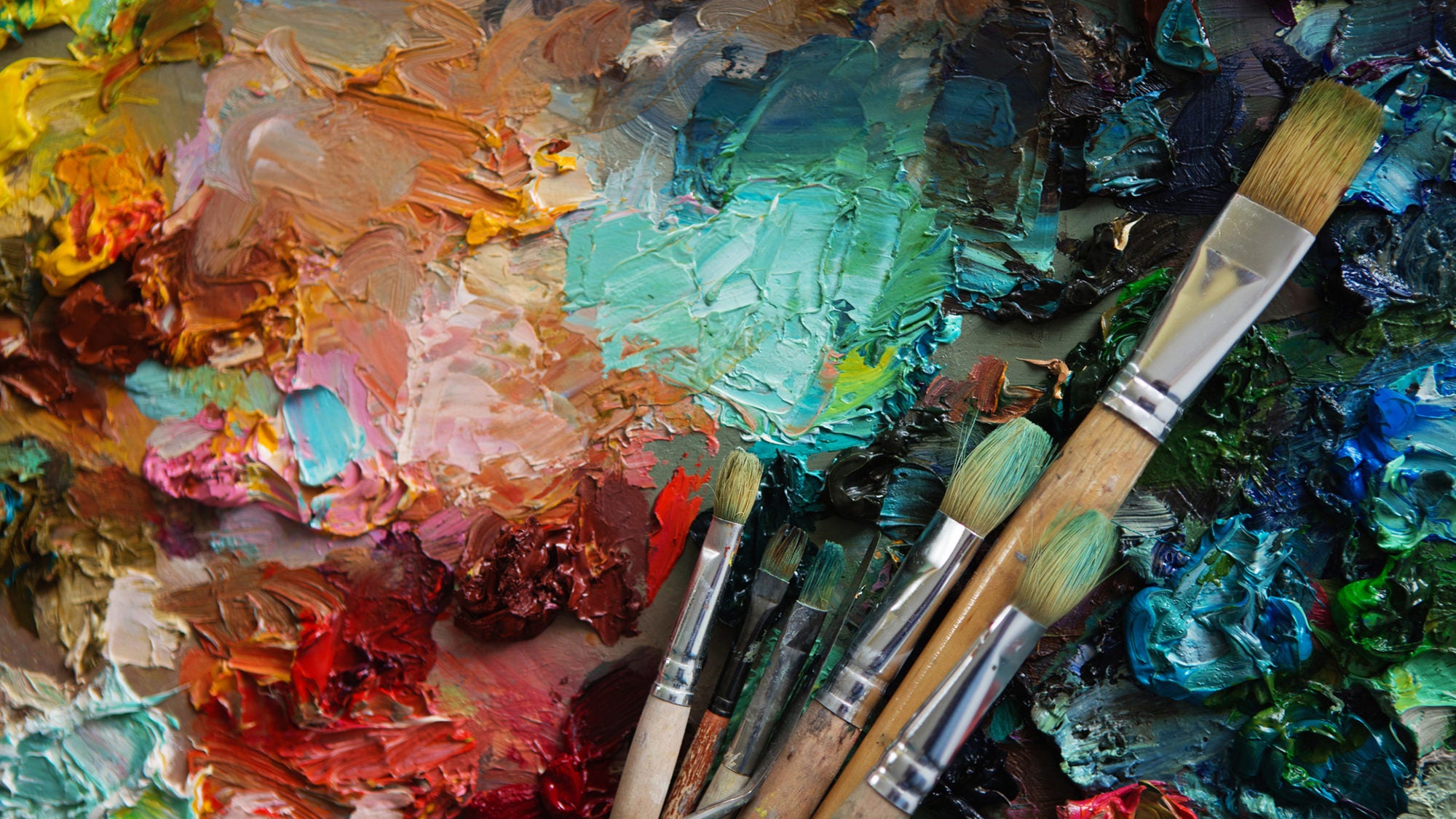
Spring 2023 Course Guide
Spring 2023 Course Guide
Welcome to the Spring 2023 Course Guide for the Department of Art and Art History!
We invite you to browse all the offerings and let us know if you have any questions. For individual courses, please reach out to the professor. For other questions about your major, minor, or our curriculum more generally, please contact your major advisor or any of us listed below. Department faculty and staff are happy to answer your questions and discuss your options by email or appointment.
Director of Undergraduate Studies in Art History – Prof. Ian Bourland
Director of Undergraduate Studies in Studio Art – Prof. Scott Hutchison
Director of MA Program in Art and Museum Studies – Prof. Lisa Strong
Department Chair — Prof. Elizabeth Prelinger
Department Coordinator – Em Aufuldish
Studio Art Courses
Design
ARTS 100-03 – Design I

Camouflage Project: In Design I, we cover color mixing and color theory. In this project, by Elena Zheng, the students were asked to think about the idea of camouflage and how to integrate two or more natural or man made objects by thinking about their color placement and arrangement.
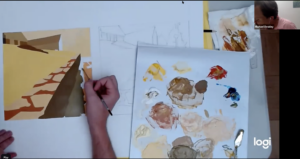
Experimental color compositions: In this project (seen here: Professor Dowley’s demonstration) students use their own photographs of architectural spaces to develop two simplified color compositions. One of the compositions will be monochromatic (one primary color is chosen as a starting color) and the other is developed from complimentary colors.

Paper Cutting: Students learn to cut intricate designs using only paper and x-acto knives. Students develop their images from their own photography and from drawings.(student work: Cornelia Thomas)
ARTS 100-03 — Design I is an introductory art studio course. Using drawing, painting, sculpture and photo materials, students learn the principles and elements of design necessary to communicate and express themselves visually. Special topics include collage and papercutting. ARTS 100 is required for all art majors and is recommended for art minors and as an elective for students interested in exploring the discipline of studio art.
This course is taught by Professor Michael Dowley.
ARTS 100-04 – Design I
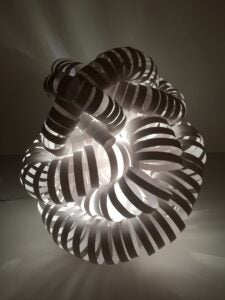
Alexandra Smalto, Paper Luminary Project
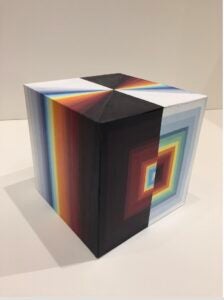
Angela Liu, Color Cube Project

Assignment covering Line and Plane Elements with Repetition and Difference Principles
ARTS 100-04 – Design I focuses on the study of fundamental skills used for making visual art. This includes both conceptual and technical development. The broad goals of the course are to train our eye to understand and refine compositions as a way to communicate ideas visually and create new designs that get past cliche ideas. Additionally, we will gain foundational skills and concepts needed for making and analyzing art. This section of Design will focus on creating three-dimensional forms using easy-to-manipulate materials such as paper, cardboard, foam-board and wire. With these materials all of the projects will be achievable in practically any learning environment.
This course is taught by Professor Evan Reed.
Drawing
ARTS 110-01 – Drawing I: Visual Language
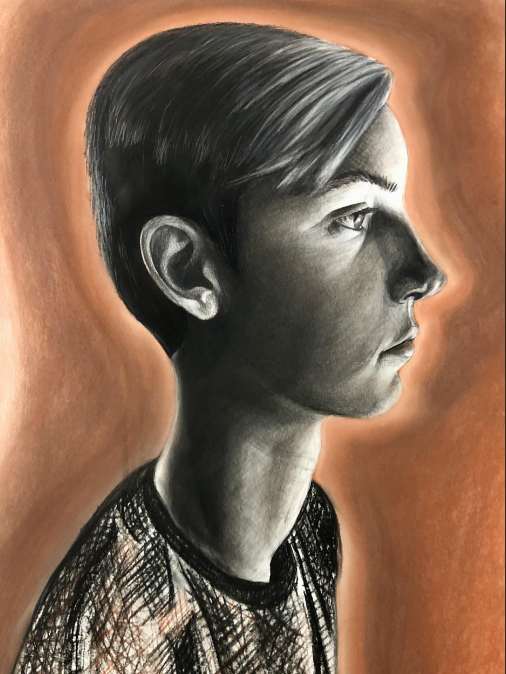
Peris Lopez, Profile Portrait Drawing
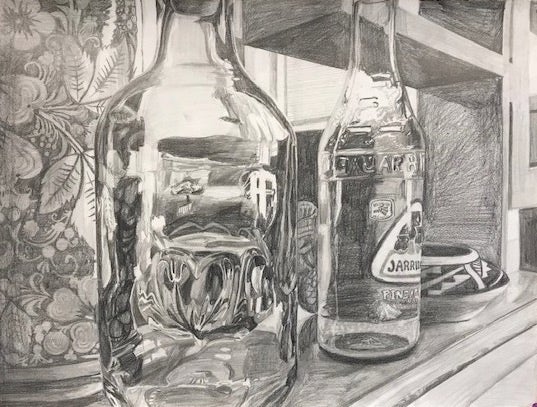
Anastasia Wass, Drawing Glass

Julia Gigante, High Contrast Drawing
ARTS 110-01 – Drawing I: Visual Language Gustav Klimt once said, “Art is a line around your thoughts.” In this course, students will use drawing as a means of creative reflection and as a means to process the world around them. Students will draw inspiration for their work from their personal-history and surrounding environments. They will learn to see the world from a new perspective, and with fresh eyes. This course will begin with foundational material, building step by step in complexity. Students will use checklists to help them to develop and fix line drawing, shading, and composition. Understanding that students have different levels of drawing experience, I work with each student individually to help them improve. Using interactive group critiques and one-on-one feedback from me, all students will gain valuable feedback on their drawings. A variety of drawing processes and techniques will be covered. Subjects covered will include still life, landscape, portraiture, the figure, and architectural perspective drawing.
This course is taught by Professor Marisa Stratton.
ARTS 110-02 & 03 – Drawing I: Visual Language

Gabriella Petreski; BIG Critter Project: Charcoal on Paper
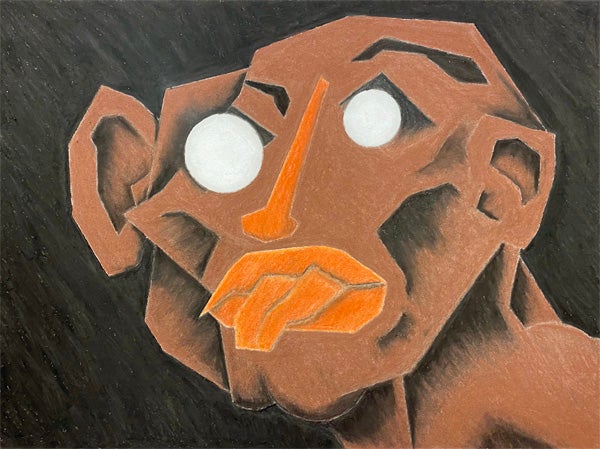
Mario Cobo-Aguirre; Song Interpretation: Conte Crayon on Paper

Susan Rogers; Value Study: All White Objects Still Life
ARTS 110-02 – Drawing I: Visual Language is a course designed to introduce basic fundamentals of drawing, with an emphasis on perceptive and technical skills. Basic art elements, and principles of art are explored as they relate to graphic expression. Additionally, this course is designed to develop basic drawing skills using a variety of media and techniques, and to become knowledgeable of various topics, and vocabulary in drawing such as line, tone, perspective, proportion, and composition. Another purpose of this course is to develop basic critical skills in visual art, and to expand elements of visual and critical thinking, and visual vocabulary.
This course is taught by Professor Tom Xenakis.
ARTS 110-04 – Drawing I: Visual Language
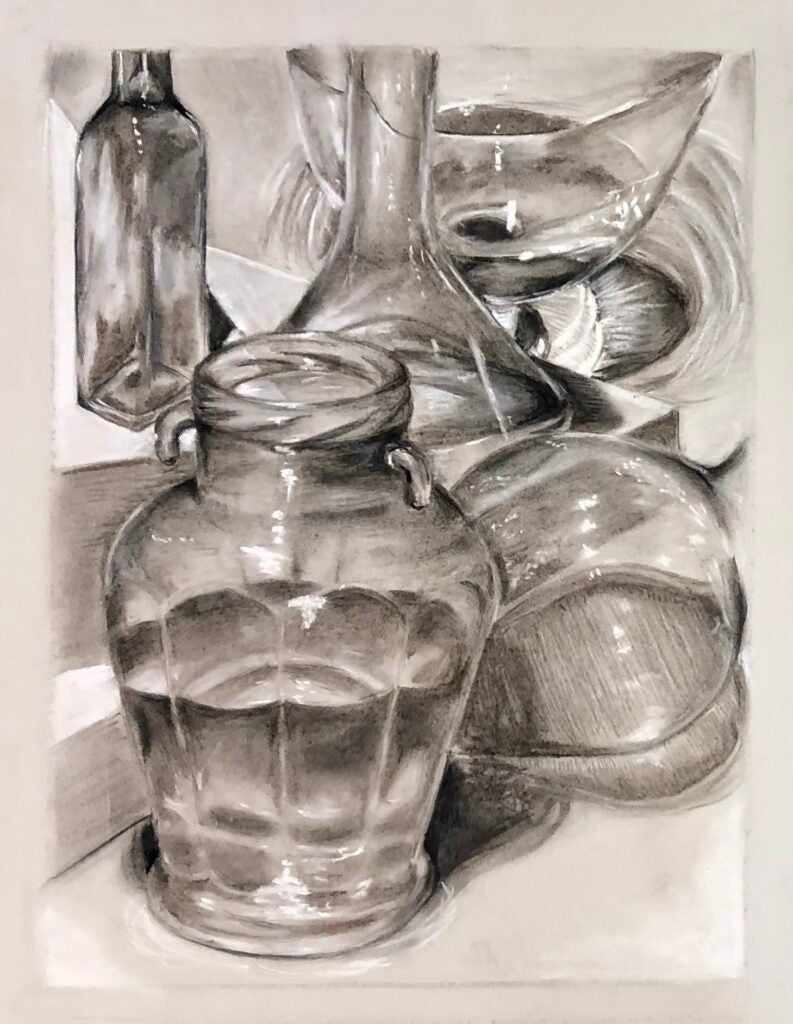
Jenna Royson, Reflections
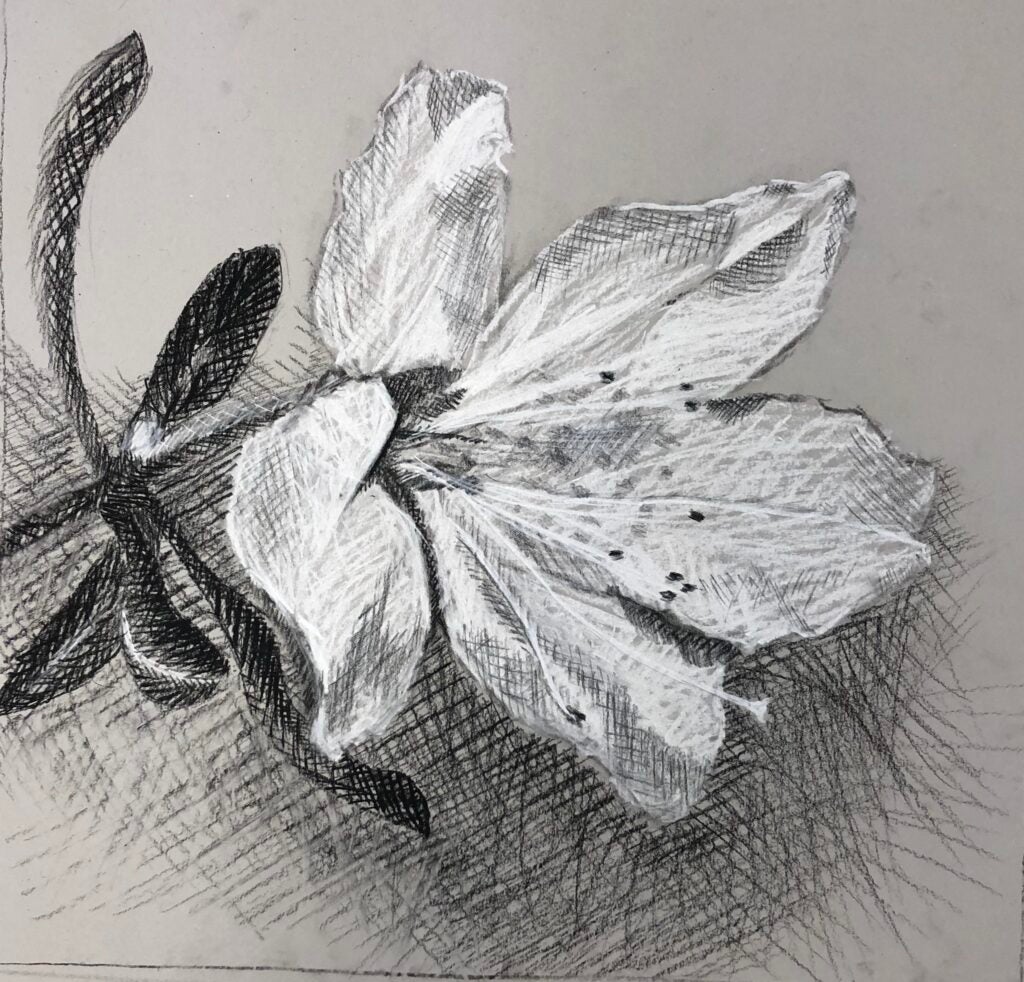
Kent Hall, Flower study
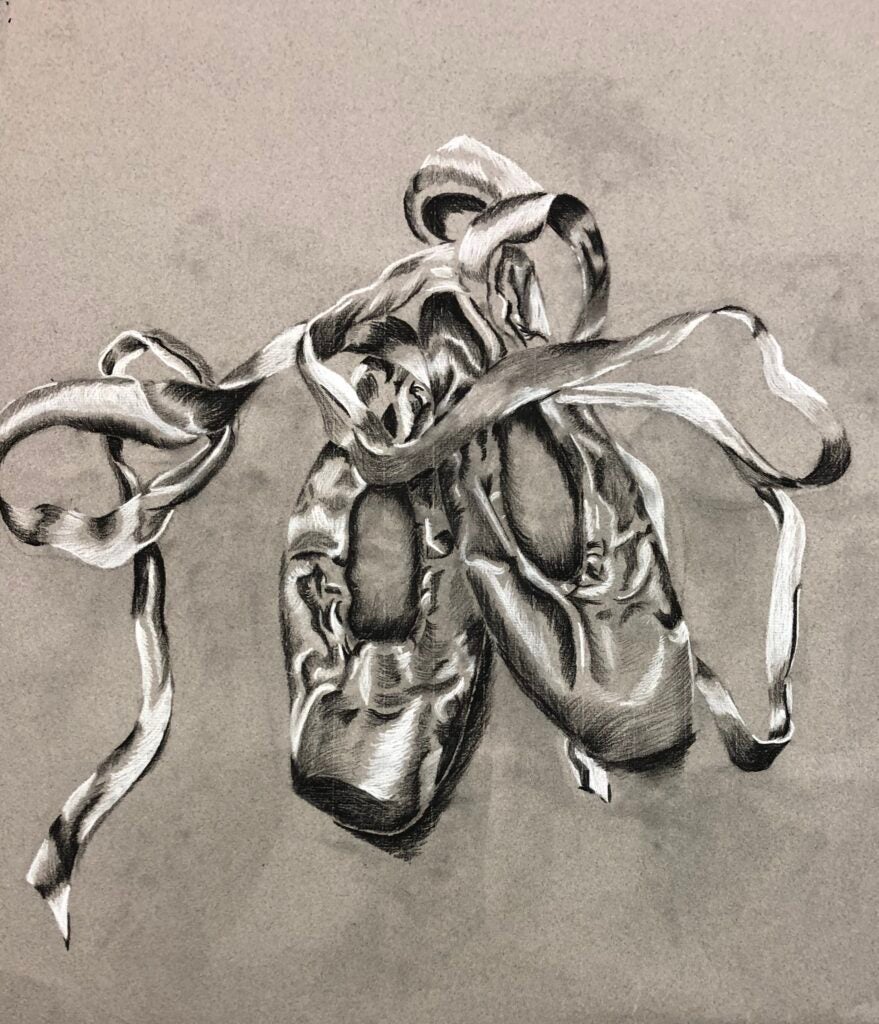
Jade Murphy, Ballet Slippers
ARTS 110-04 – Drawing I: Visual Language In this course, students explore drawing as a graphic means to process the world around them. The class starts with the fundamentals of composition, and how to use light and shadow to describe form. We then look at line as a means of discovery and expression, along with other techniques of rendering form, space and texture. Projects range from still life and interiors to studies of nature, animal skulls and the portrait/figure. Students are approached on an individual basis as well as through group discussions, slideshows, demonstrations and critiques. “Learning to draw is really a matter of learning to see.” – Kimon Nicolaides.
This course is taught by Professor Ann Schlesinger.
ARTS-211-01 — Drawing II: Figure
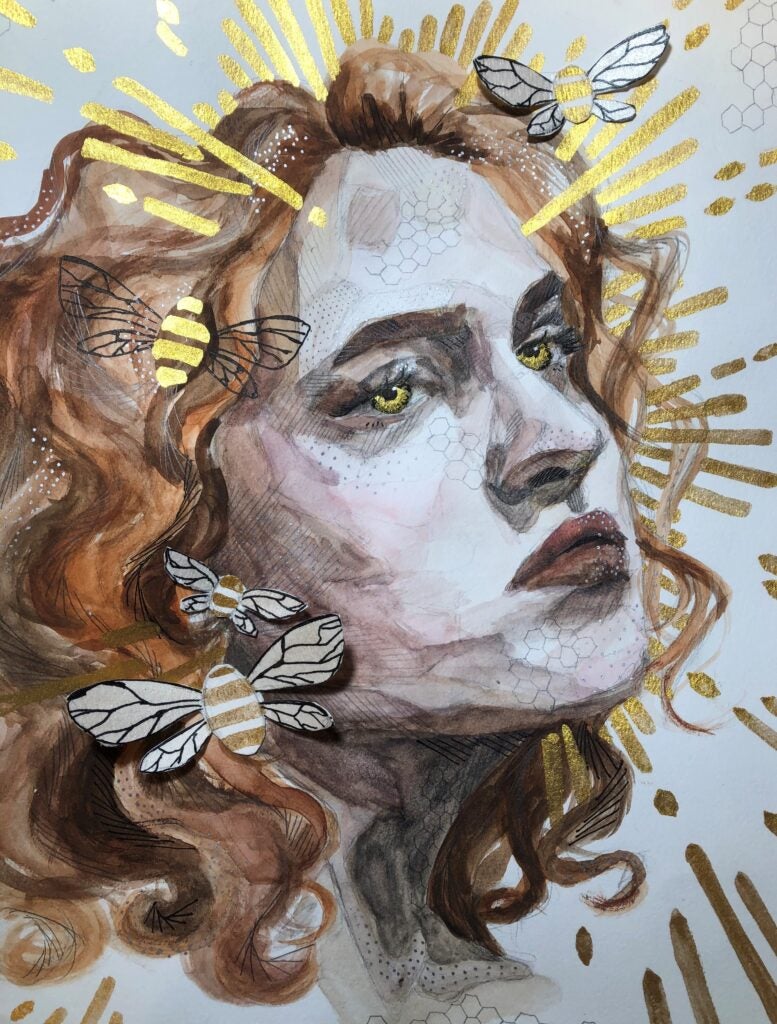
Nell DiPasquantonio
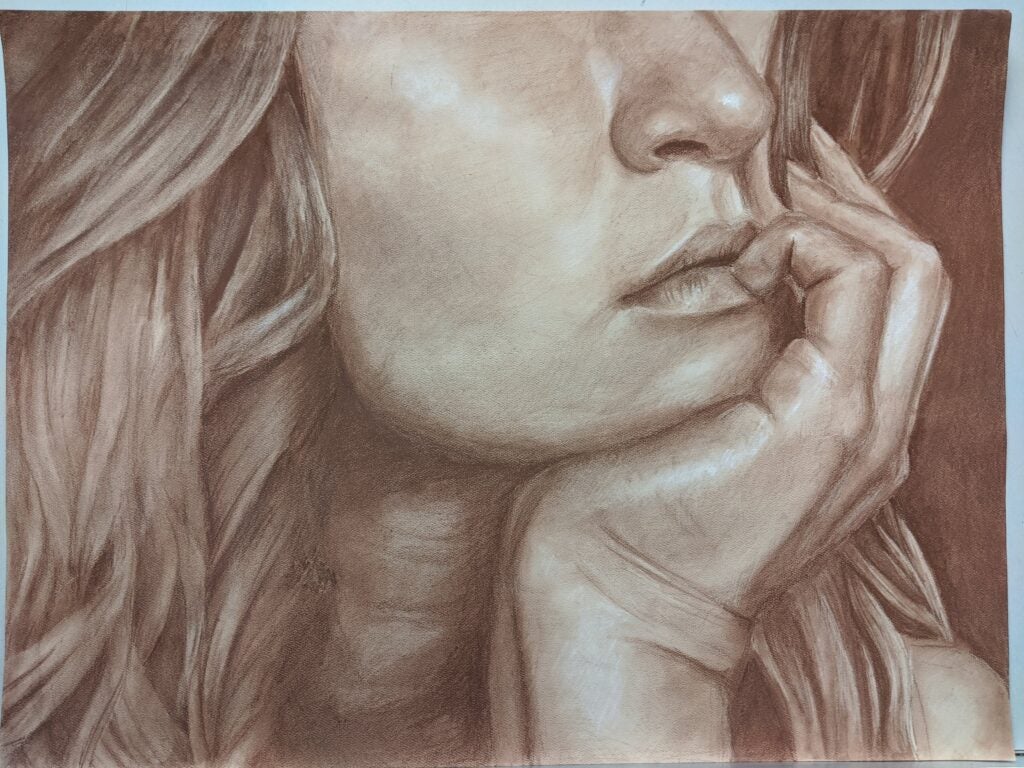
Izzy Hansen
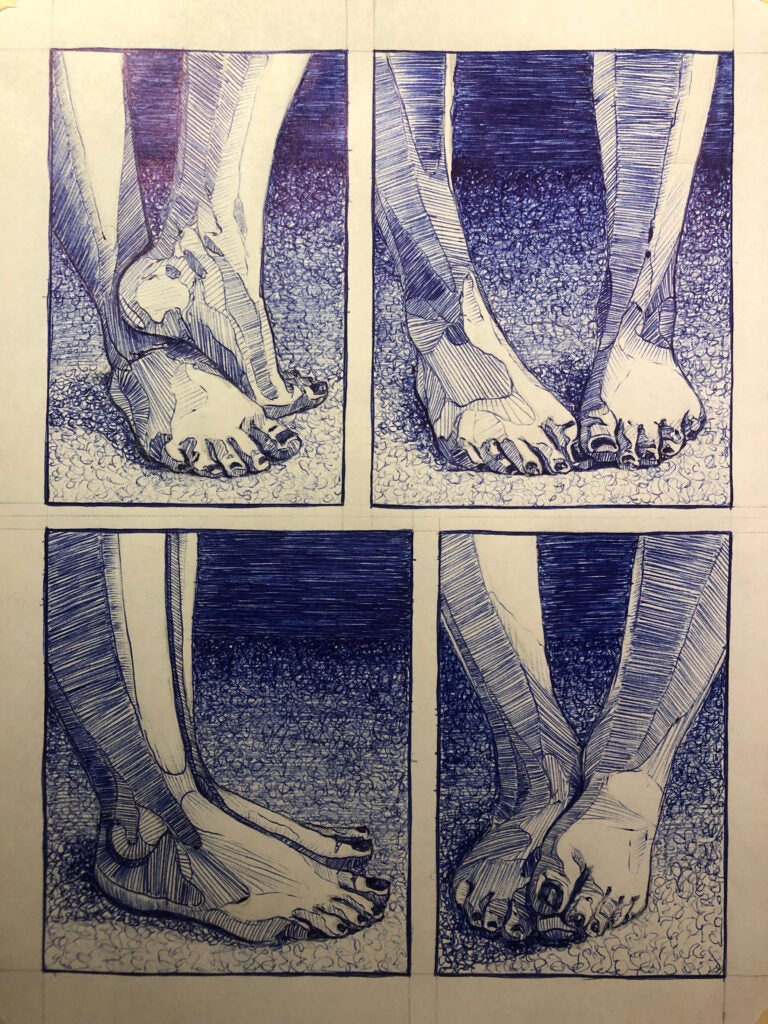
Egan Barnitt
ARTS-211-01 — Drawing II: Figure: This course is an exploration of the figure through a variety of mediums and tools of expression with the purpose of applying them towards the creation of an individualized and cohesive body of work. You will be expected to work both in-class and independently on a variety of projects. Every drawing in this class will contain skill-building elements and also encourage you to use your own unique aesthetic and individual critical decision-making skills. Class critiques will also be incorporated into the course and each student will develop the importance of presentation and the ability to analyze and critique using the vocabulary of visual art.
This course is taught by Professor Scott Hutchison.
ARTS 216-01 – Drawing II: Themes & Explorations

Kent Hall, Self-portrait
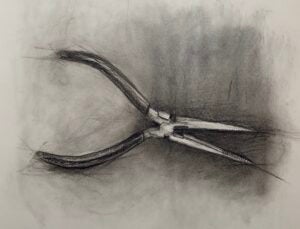
Reagan Graney, Needlenose pliers
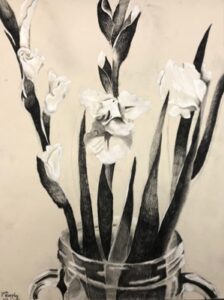
Jade Murphy, Flower study
ARTS 216-01 – Drawing II: Themes & Explorations In this course, students explore the unique way that drawing as a discipline lets them investigate and interpret the world around them, as well as further develop their ideas of visual language and expression. Students focus on three to four themes of personal interest, with the goal of creating a portfolio in which a variety of drawing approaches and concepts are explored in depth. Possible themes could include: portrait/ self-portrait; forms of the natural world (plants, roots, skulls); personal objects that convey character; landscape, architecture or figures within a space; texture, surface and/or space as an expressive tool, etc. The course is highly individualized, adjusted to each student’s interests and goals, and its main emphasis will be for students to experiment with and push visual ideas and concepts in drawing.
This course is taught by Professor Ann Schlesinger.
Printmaking
ARTS 121-01 — Intro to Printmaking
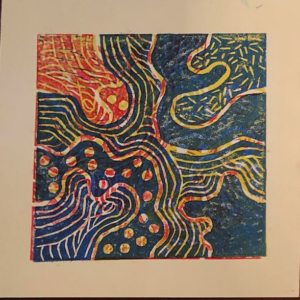
Grace Nguyen
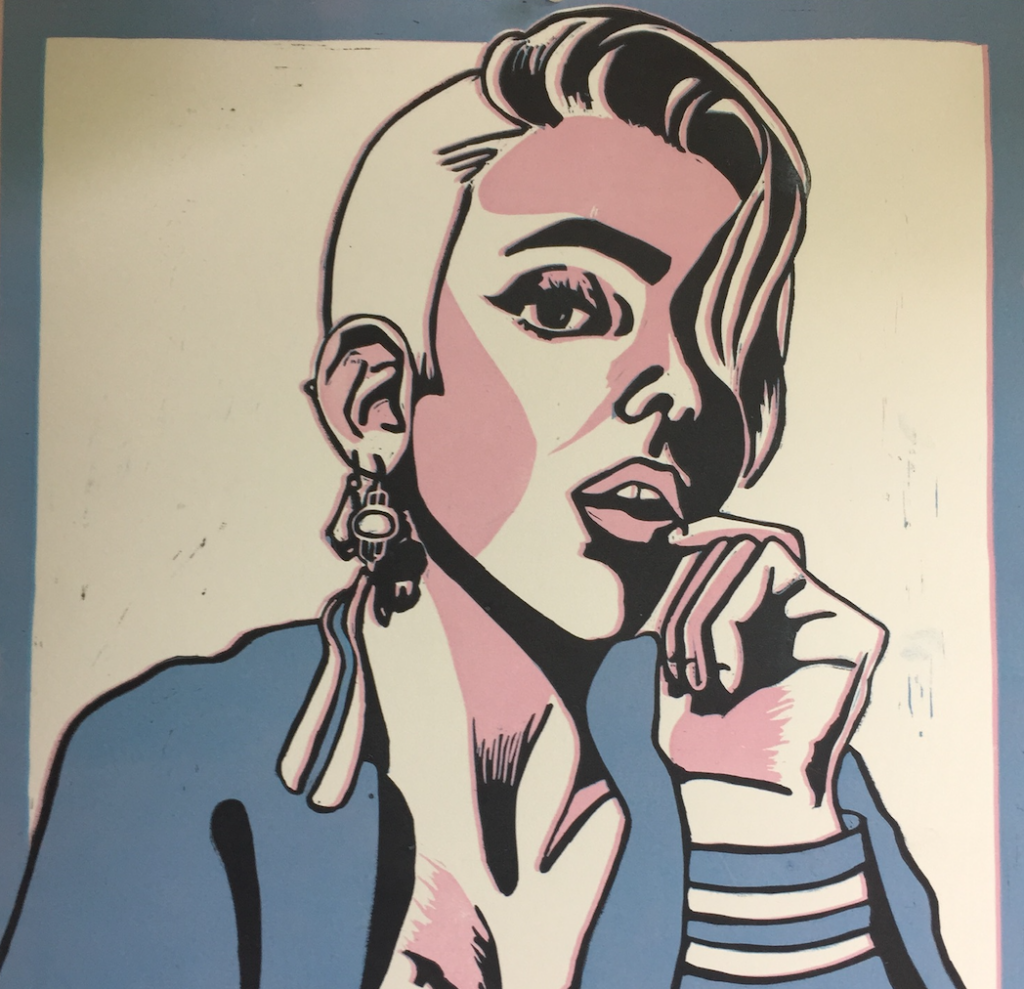
Tyler McConville

Grace Nguyen
ARTS 121-01 — Intro to Printmaking This course utilizes traditional hand printing of relief images from Linoleum plates. Test plates are done in color and B&W. Folds and simple bookmaking are presented as options. After learning safe cutting, registration and printing methods, students are encouraged to pursue their own personal imagery. Critiques and view and response of videos and online print related sites is required.
This course is taught by Professor Scip Barnhart.
ARTS 170-01 — Art of the Book

Olivia Tatarian
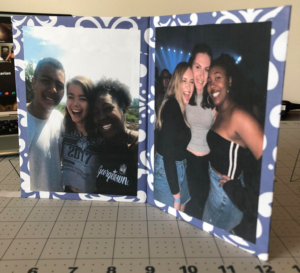
Jordyn Jones
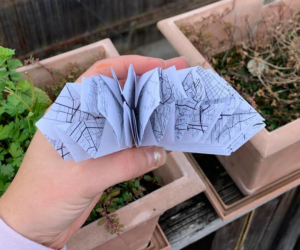
Olivia Tatarian
ARTS 170-01 — Art of the Book This course explores the practice and creation of unique artist books. Multiple bindings, sewing, folds, cutting methods, and techniques are taught to prepare students for personal expression through hand made books.
This course is taught by Professor Scip Barnhart.
Photography
ARTS 131-01 – Photo 1: Digital

Abel Teffra, Fall 2020

Valerie Sanchez, Summer 2020
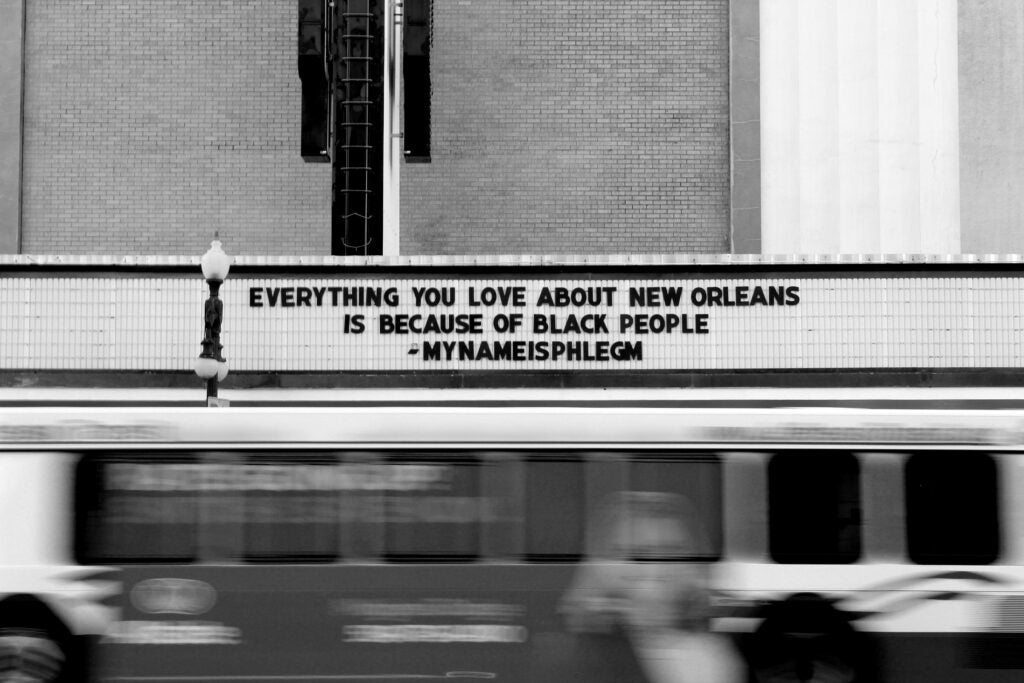
Leo Arnett, Summer 2020
ARTS 131-01 — Photo 1: Digital is a basic digital photography studio art course designed to develop the hands-on skills necessary to produce and identify the elements of a good photograph and to acquire a thorough working knowledge of digital equipment. Students will gain an understanding of the aesthetic and technical areas of photography as a fine art. Class lectures, discussions and digital assignments will deal with photographic composition, criticism and history. Fundamental knowledge of computer programs such as Photoshop will be introduced in the semester to develop photographic imagery.
This course is taught by Professor Kelly Carr.
ARTS 131-02 – Photo 1: Digital
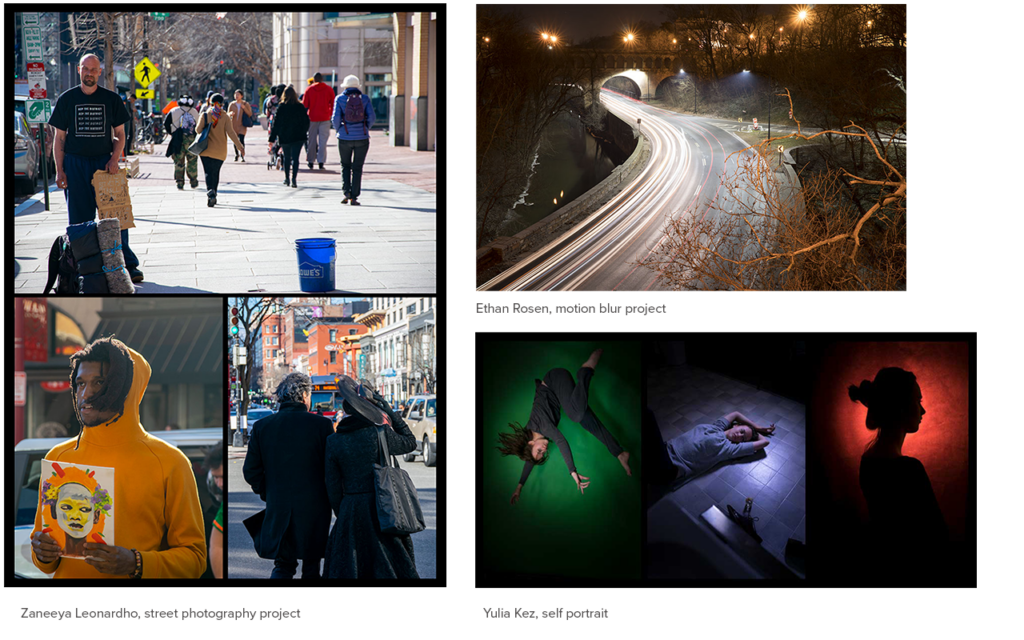
ARTS-131-02 — Photo 1: Digital is an introductory digital photography studio art course designed to develop the hands-on skills necessary to produce and identify the elements of a good photograph and to acquire a thorough working knowledge of digital equipment. Students will gain an understanding of the aesthetic and technical areas of photography as a fine art. Class lectures, discussions and digital lab assignments will deal with photographic composition, criticism and history, camera and paper types, and printer systems. Fundamental knowledge of computer programs such as Photoshop will be covered for students to edit and print their work. Students enrolled in studio courses must devote a minimum of FOUR TO SIX hours per week outside of class to develop and complete assignments. Through the analysis of the history of this medium this class involves the study of photography as a metaphor for the human condition with students engaging in self-reflection and questioning through analysis, inquiry, dialogue and creation. This course fulfills the Georgetown HALC (Humanities, Art, Literature and Culture requirement) requirement.
This course is taught by Professor Roberto Bocci.
ARTS 131-03 – Photo 1: Digital
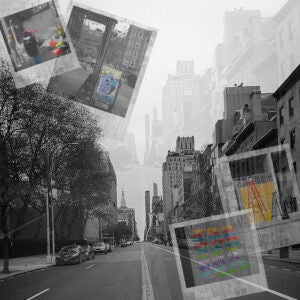
Andrea Cano, Final portfolio work
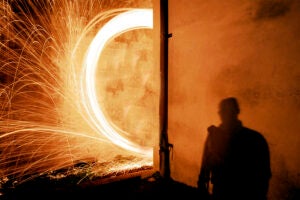
Carl Wegner, Final portfolio work

Final portfolio work.
ARTS 131-03 — Photo 1: Digital Photography plays a predominant role in how we explore and express ourselves, how we connect. Even after the pandemic, that will still be true. This class explores how the craft challenges, the cultural framework, and the photographer’s perspective are potential tools to help be better at making and understanding photographs. The sample images are student’s final portfolios from Fall 2020. I am humbled by how much progress the students made even as we explored without the possibility of brainstorming face-to-face around a table.
This course is taught by Professor Bruce McKaig.
ARTS 132-01, Alternative Processes in Photo

Margaret Neely; DSLR Pinhole Camera
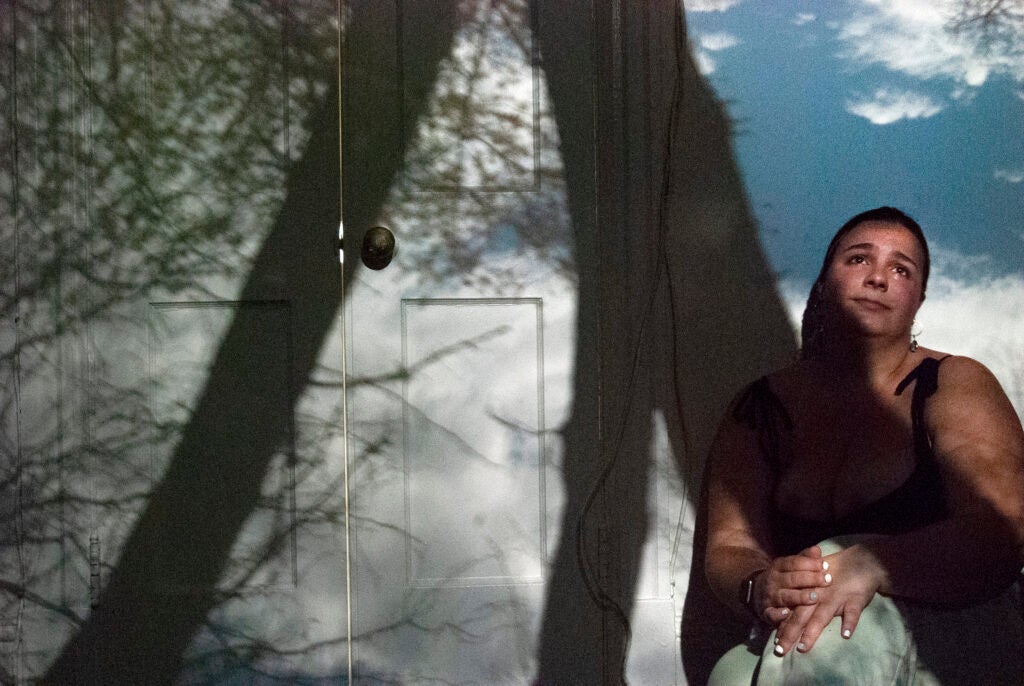
Katie Watke; Camera Obscura

Lovell Smith; Gesso Transfer Print
ARTS 132-01 — Alternative Processes in Photo Back in the day meets modern day, contemporary alternative photographic processes. This class combines modern day technology with historic non-traditional printing and photographic processes. DSLR cameras and photo editing software are applied to centuries old photographic processes. Students will gain knowledge of both digital and hands-on non-traditional processes. Additionally, the class will include discussions as to history, invention, and contemporary artist regarding each process.
This course is taught by Professor Kelly Carr.
ARTS 132-02, Alternative Processes in Photo

Ambient Light Gelatin Silver Print
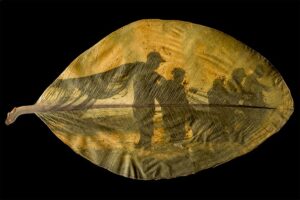
Chlorophyll Print (photo on leaf)

Photograph inside a camera obscura
ARTS 132-02 — Photo I: Alternative Processes This alternative photography studio art class challenges boundaries between historical techniques and contemporary means of expression. Students will discover a diversity of photographic processes, often without a camera, to explore how relevant they are to individual voice and contemporary art practices. Processes include but are not limited to cyanotypes, chlorophyll prints (photographs on plant leaves), pinhole photography, hand coloring, flip-books and other rudimentary motion processes, social media. Mostly a production class, students will also be introduced to other historical and contemporary examples. No experience necessary.
This course is taught by Professor Bruce McKaig.
ARTS 230 – Photography Studio II
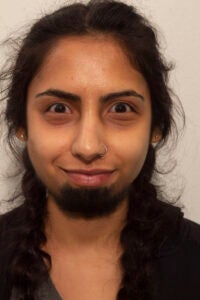
Pedro Ramirez, Nancy Burson project
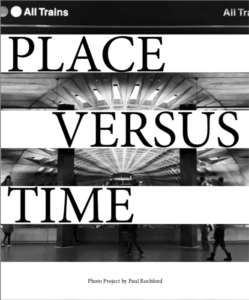
Paul Rockford, Booklet Project

Henry Smithers, Text-to-Image project
ARTS 230 – Photography Studio II is an advanced class for both film and digital photography students to continue shooting and printing their creative work in order to compile a portfolio that can be used to apply for internships, jobs or graduate school. Projects include the portrayal of a city (Washington DC and/or other), event documentation (the documentation of street events, political protests, rock concerts etc.), a book-making project that can be printed and bound in-house or sent out to companies like Blurb, and mini projects to learn how to use advanced Photoshop compositing and editing techniques. Projects can be developed on film or digital format and printed as gelatin silver and/or digital prints. As students produce work the prints are inserted into a hard copy portfolio or added to a website. The primary software packages you will use are Adobe Photoshop and Bridge and/or Adobe Lightroom.
This course is taught by Professor Roberto Bocci.
Sculpture
ARTS 140-01 & -02 – Sculpture I
There are two sections of ARTS 140, at different times.
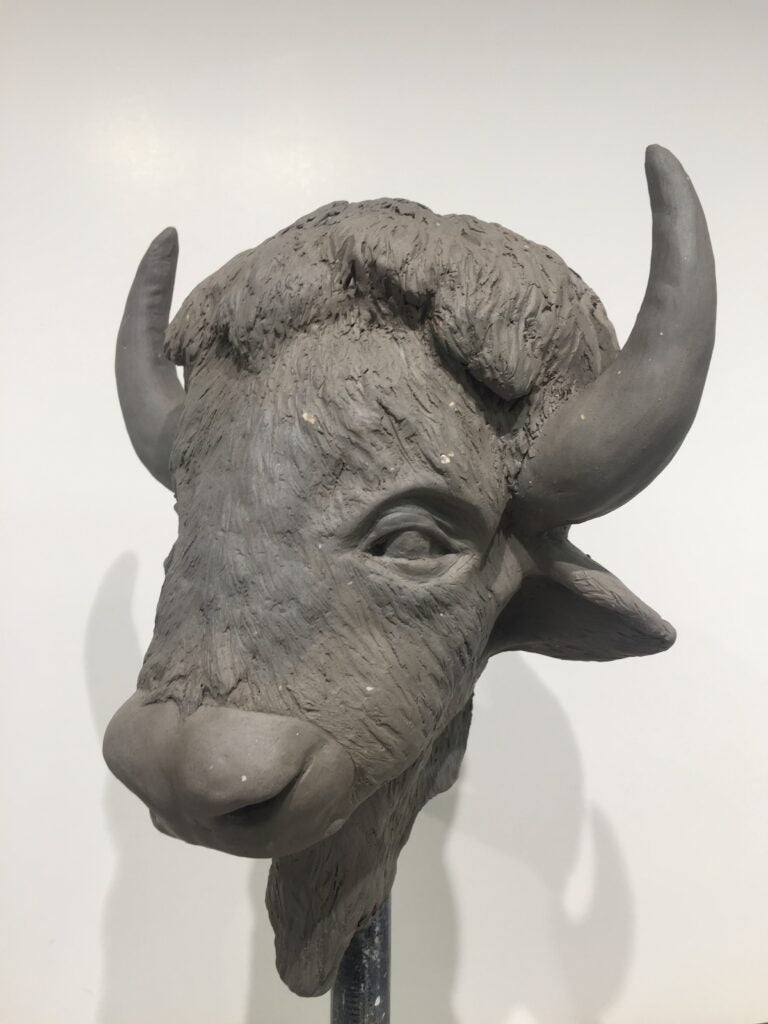
Sidney Lee, Modeling from life

Sean Letendre, Cardboard self-portrait

Corine Forward, Spring 2019, Micro Monument Assignment
ARTS 140-01 & 02 – Sculpture I offers students the opportunity to exercise their creative drive and objectify their ideas as three-dimensional form. Students work in traditional and contemporary methods and materials. During the semester there are three thematically driven projects that simultaneously introduce new materials, processes, and conceptual consideration. Assignments begin with demonstrations and example images of work by artists of different eras and previous students from Sculpture One. This spring semester Sculpture I will include projects that range from modeling a form in clay, creating sculptures with recycled cardboard and designing a miniature monument that will incorporate a range of materials. All sculptural processes will be low tech and accessible to all.
This course is taught by Professor Evan Reed.
Painting
ARTS 150-01 – Painting I: Oil
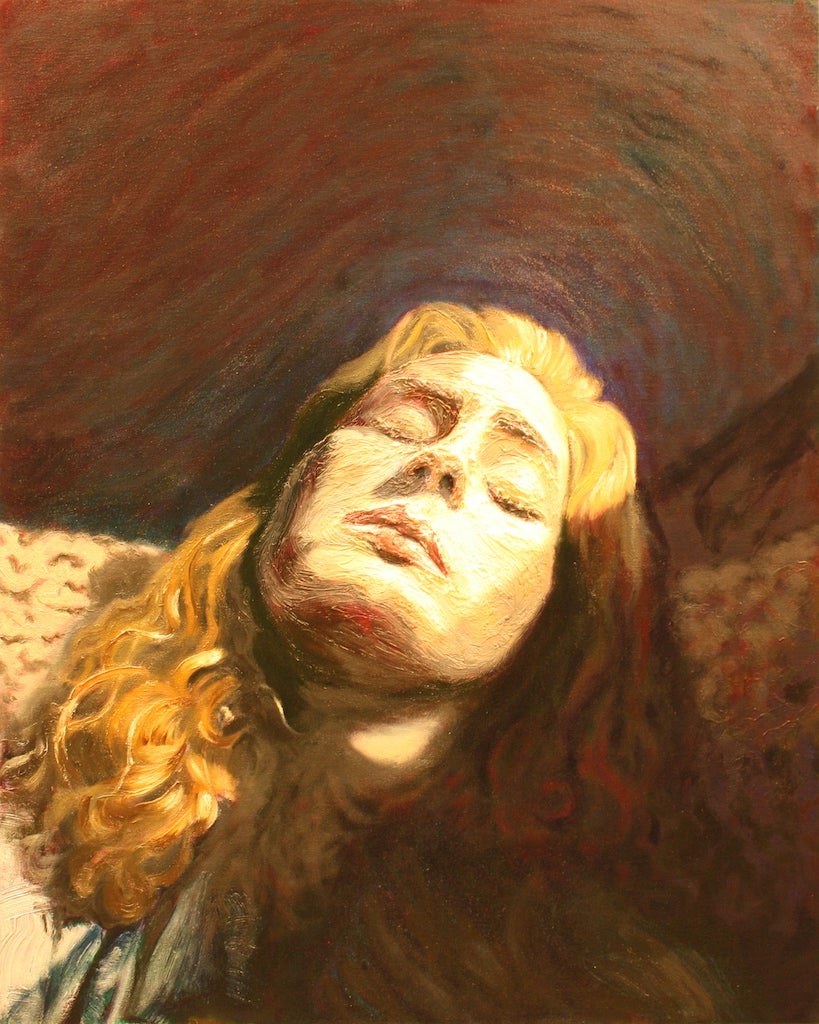
Kristina Ravensbergen, Portrait.
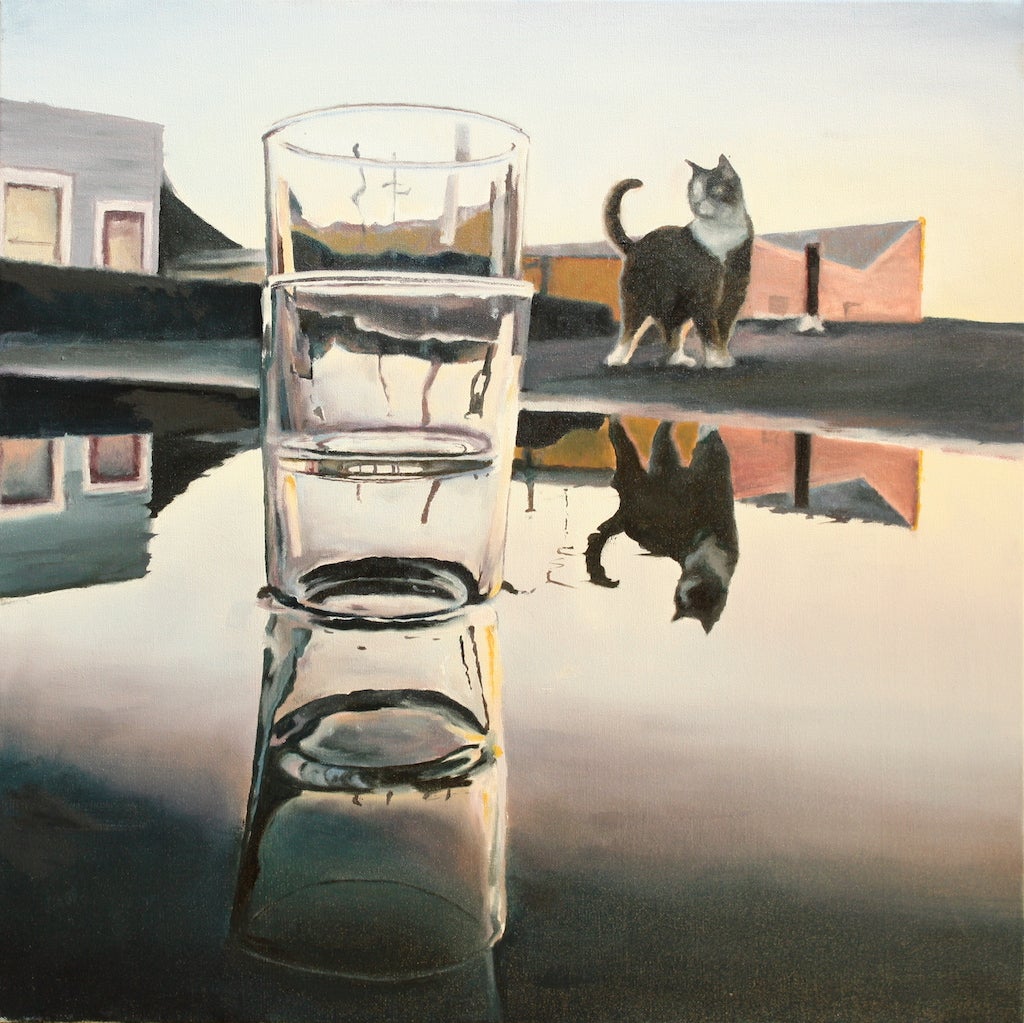
Lola Bushnell, Landscape painting.
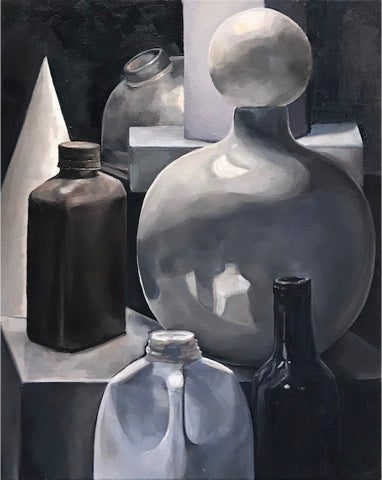
Sonya Fares, Limited palette painting.
ARTS 150-01 — Painting I: Oil Edward Hopper once said, “If I could say it in words there would be no reason to paint.” In this course, students will use paint as a means of creative expression and as a means to explore their individual interests. Students will gain inspiration for their work from their personal-history and surrounding environments. They will learn to see the world from a new perspective, and with fresh eyes. This course will begin with foundational material, building step by step in complexity. Students will explore color theory and composition. Understanding that students have different levels of painting experience, I work with each student individually to help them improve. Using interactive group critiques and one-on-one feedback from me, all students will gain valuable feedback on their drawings. A variety of painting processes and techniques will be covered. In addition to still life, students will be able to do landscape and figure paintings. As a remote course, resources will include prerecorded demonstrations, live-recorded demonstrations, slideshow lectures, and short films about artists.
This course is taught by Professor Marisa Stratton.
ARTS 150-02 – Painting I: Oil
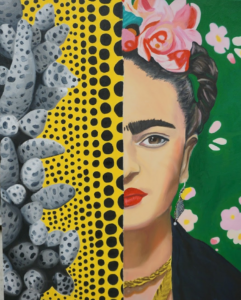
Melissa Gonzalez, Collage Painting Project
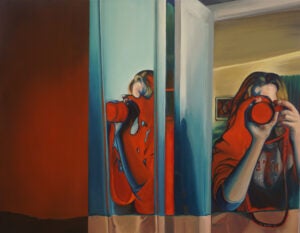
Susanna Hermann, Multiplicity Painting Project
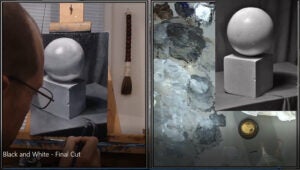
Zoom Black and White Demonstration
ARTS 150-02 — Painting I: Oil This is a studio art class developing the techniques and concepts of painting in traditional, oil medium used from the Renaissance to today. Students will learn the basic techniques of transparent glazing, opaque oil painting and investigate the impact of color and value on the illusion of space and form. While focusing on the traditional subjects of landscape, still life, and figure, students create a portfolio of three or four paintings during regular class sessions with feedback from the instructor and from student discussions during class critiques. The goal of this course is to strike a balance between traditional approaches to the painted surface with your own unique vision and individual critical decision-making skills. Expect to paint, inside and outside of class!
This course is taught by Professor Scott Hutchison.
ARTS 150-03 – Painting I: Oil
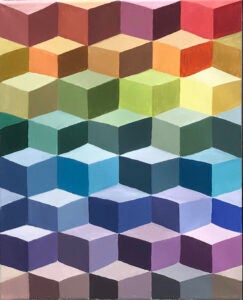
Julia Tolfa.
Oil on canvas.
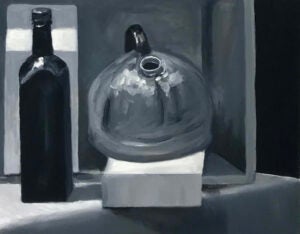
Ethan Clark
Oil on canvas.
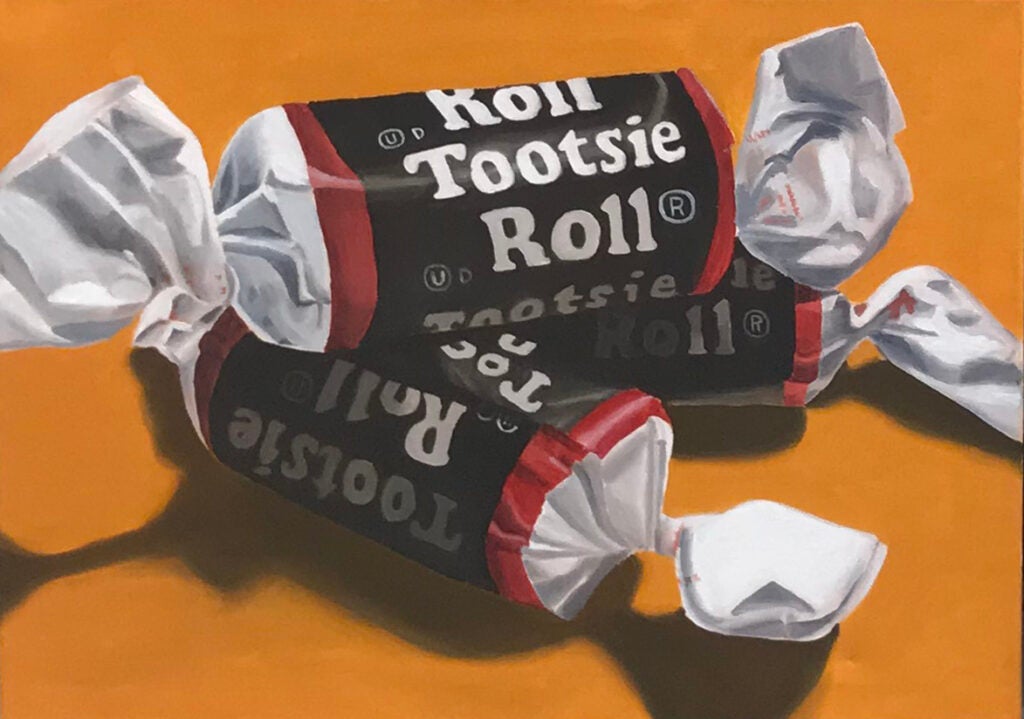
Julia Tolfa.
Oil on canvas.
ARTS 150-03 – Painting I: Oil, is a studio art class developing the techniques and concepts of painting in traditional, oil medium used from the Renaissance to today. Students will learn the basic techniques of transparent glazing and opaque oil painting. They will investigate the impact of color and value on the illusion of space and form. While focusing on the traditional subjects of landscape, still life, and figure, they will create a portfolio of three paintings developing their drawing and painting abilities with the medium. Studio demonstrations, lectures, slide presentations and individual and class critiques will be conducted online using Zoom and Canvas to present all aspects of instruction. Students create oil paintings during regular class sessions with feedback from the instructor. They continue to develop their paintings outside of class. The students receive individual guidance and evaluations from the instructor during each class as well as valuable insights from the student discussions during class critiques.
This course is taught by Professor John Morrell.
ARTS 151 – Painting I: Acrylic
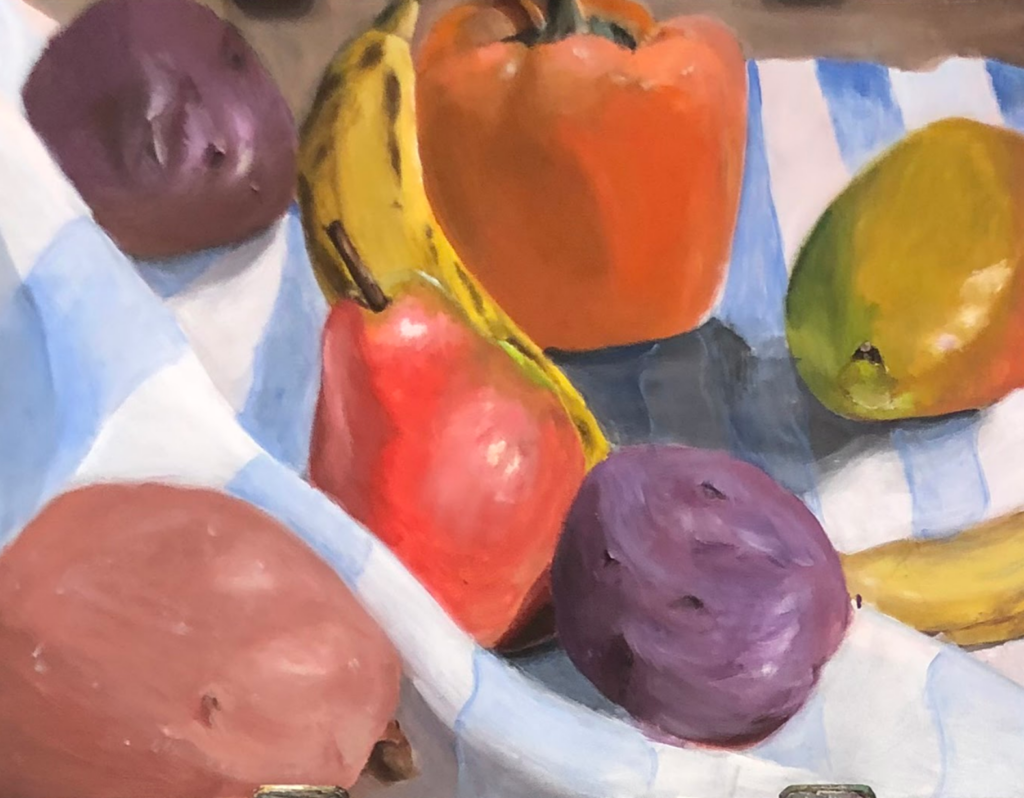
Project 3: Fruit with multiple colors
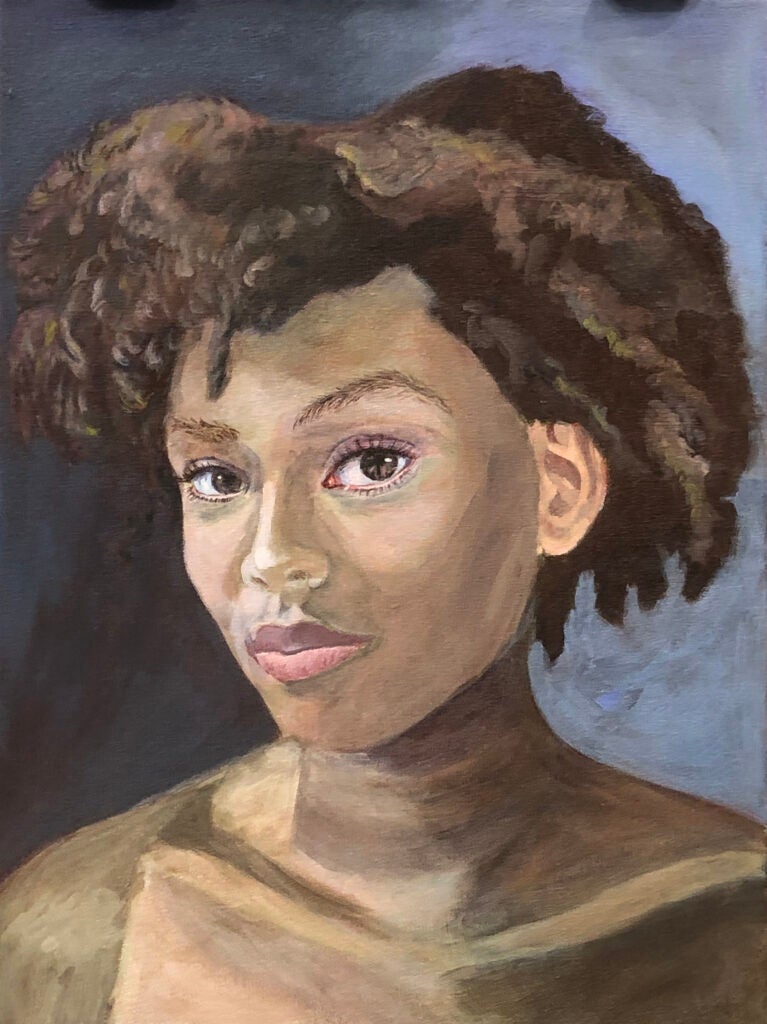
Allemai Dagnatgchew, Project 4: Self-portrait
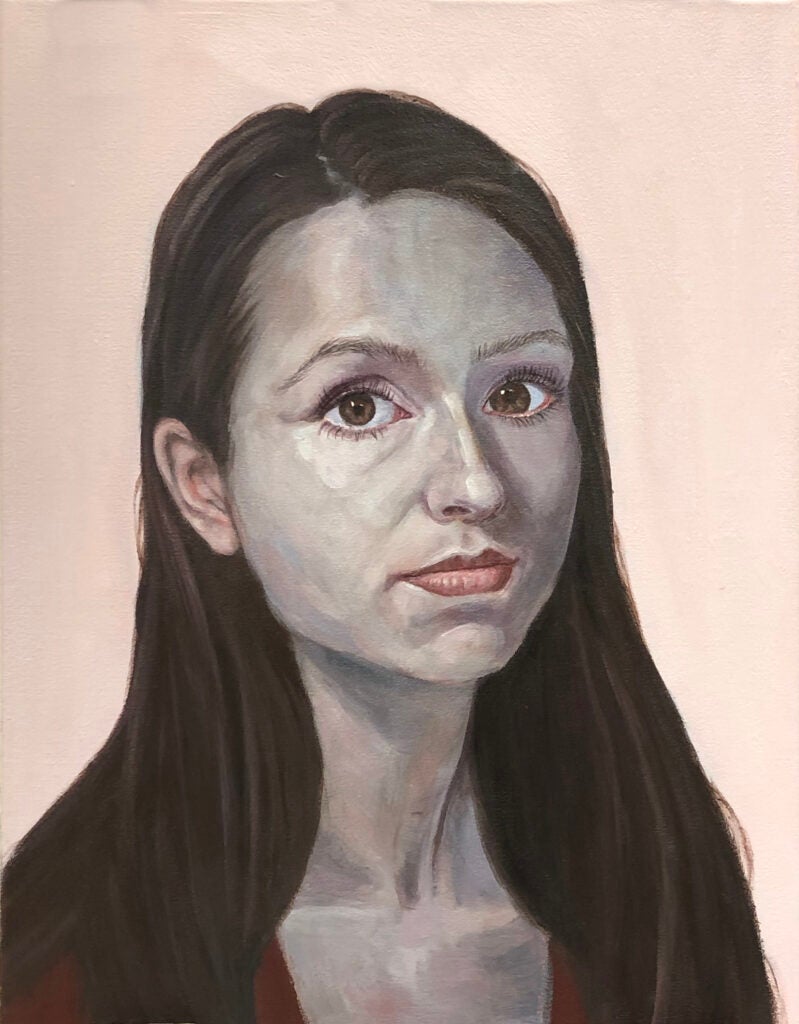
Kristen Hovland, Project 4: Self-portrait
ARTS 151 – Painting I: Acrylic This is an introductory course that consists of lectures and studio labs. This course focuses on both the acquisition of fundamental knowledge of acrylic painting, and the creation of paintings using one’s own unique imagery. Relevant art historical references and resources will be introduced for students to contextualize their work in reference to art history. Students will utilize critical thinking and problem-solving skills by engaging in progressively challenging assignments. As they work on these assignments throughout the semester, they will develop a more sophisticated aesthetic approach in the areas of color, composition, perspective, balance, and subject matter. There will be five class critiques (four critiques for each individual assignment and the final critique for the entire course) throughout the semester and each student will have opportunities to discuss their work as well as the work of others.
This course is taught by Professor BG Muhn.
ARTS 154 01 – Intro to Watercolor
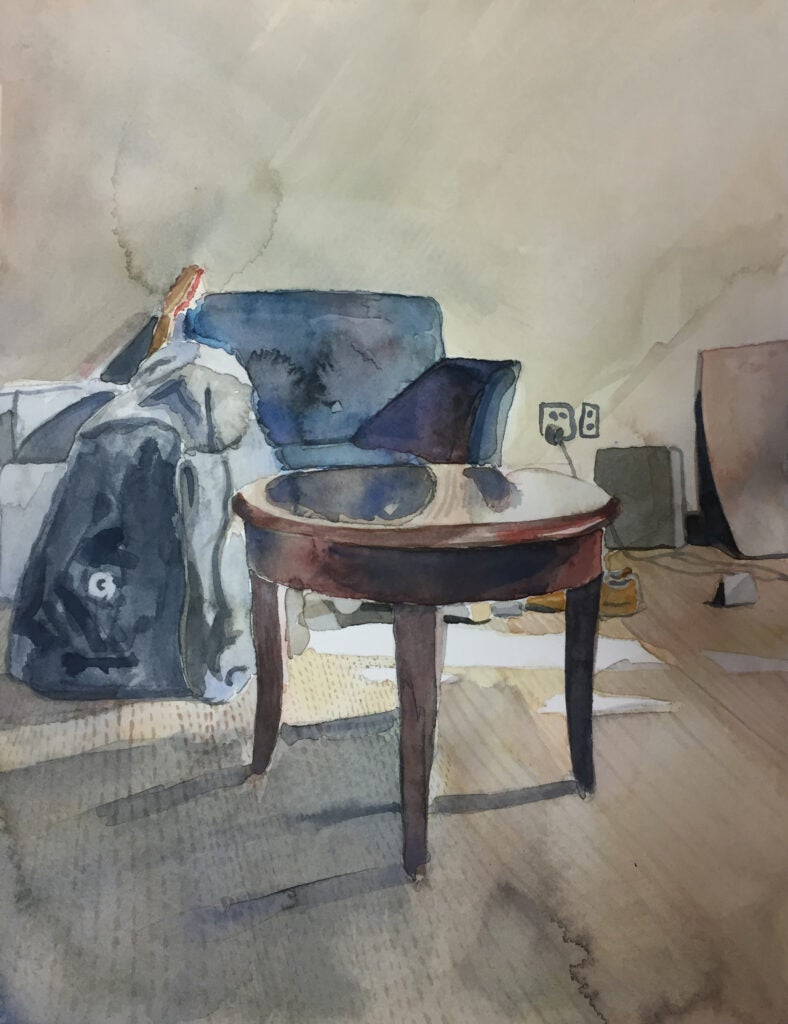
Edson Martinez.
Watercolor on paper.

Danielle Deiotte.
Watercolor on paper.

Jack Wathieu.
Watercolor on paper.
ARTS 154 01 — Intro to Watercolor, is a studio art class developing the techniques and concepts of painting in traditional, water-based medium. Students will learn the basic techniques of transparent and opaque watercolor. They will investigate the impact of color and value on the illusion of space and form. While focusing on the traditional subjects of landscape, still life, and figure, they will create a portfolio of five images developing their drawing and painting abilities with the medium. Studio projects (watercolors), demonstrations, lectures, and; individual and class critiques will be conducted online using Zoom and Canvas to present all aspects of instruction — technique demonstrations, slide presentations and class discussion. Students create watercolors during regular class sessions for one-on-one feedback from the instructor and they continue to develop their paintings outside of class. The students receive individual guidance and evaluations from the instructor during each class as well as valuable insights from the student discussions during class critiques.
This course is taught by Professor John Morrell.
ARTS 250 — Painting Studio II
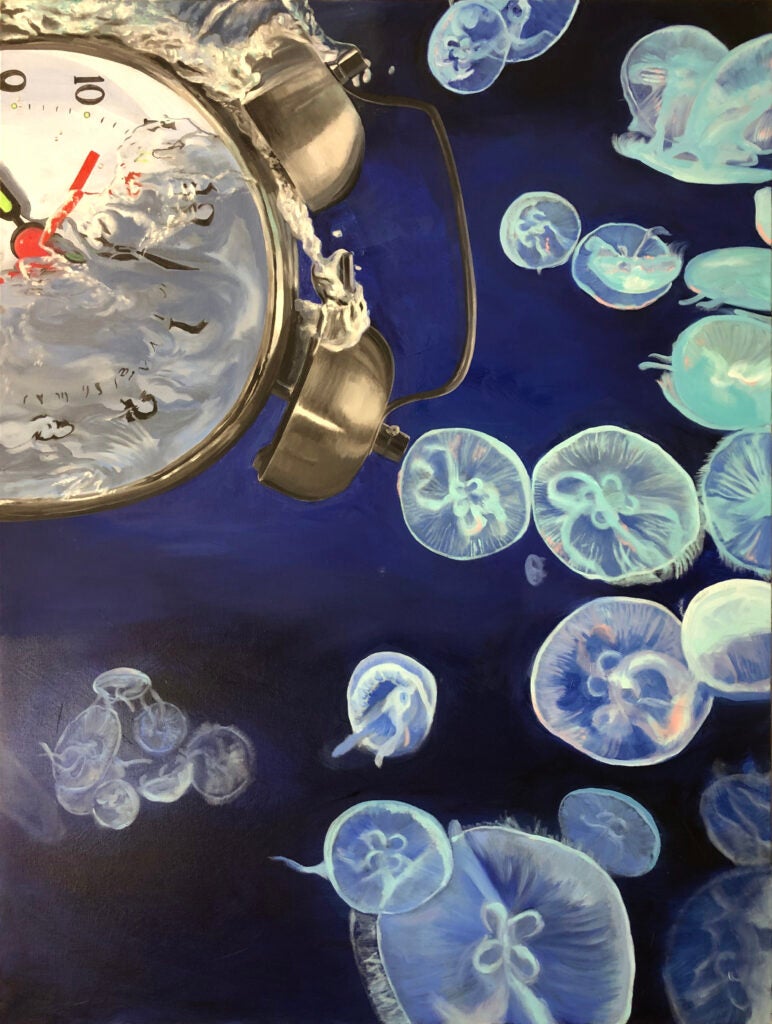
Jude An, Project 1: Conceptual Container
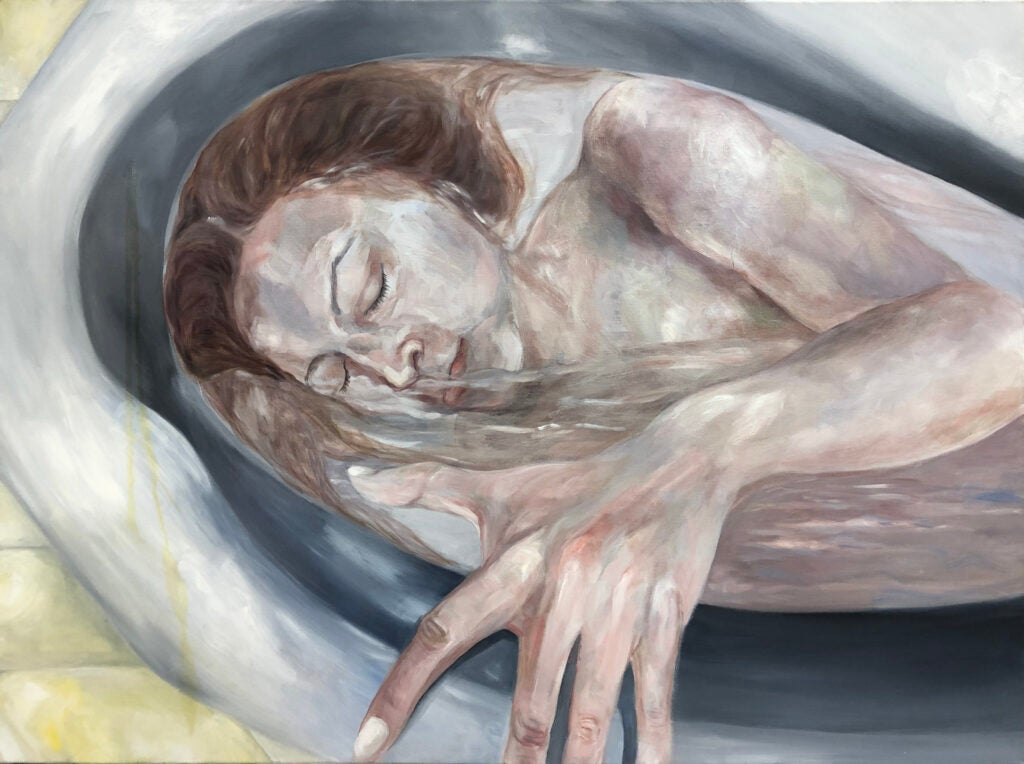
Christina Shoucair, Project 1: Conceptual Container
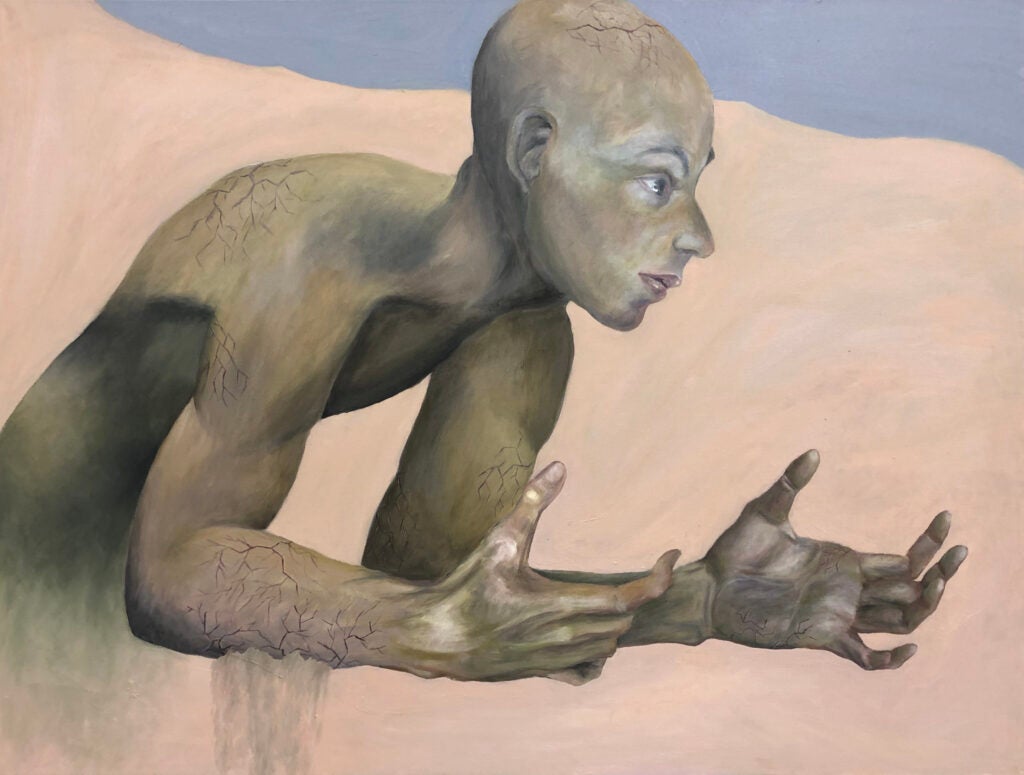
Sharon Huynh, Project 2: Human Body
ARTS 250 — Painting Studio II This intermediate painting course will have three projects. The theme of all three projects is “the unreal within the real” or “the real within the unreal.” As an example, the first project, “container” might be created as follows. Since we do not have the classroom space to set up a still life of containers such as bowls, cups, bottles, etc., each of you can set up your own still life using any containers in your home. Then you can add an image that offers an “unreal,” “unlikely,” or “unexpected” element to the still life setup. You will create your artwork (sketch first) by combining your image with the still life. The image can be your drawing, photograph, reproduction (e.g., images from magazines) or another object (e.g., stuffed animal). Another way to create “real vs. unreal” artwork can be by situating your still life in an unlikely environment, such as in the ocean or desert.
This course is taught by Professor BG Muhn.
Graphic Design
ARTS 162 01 – Intro to Graphic Design
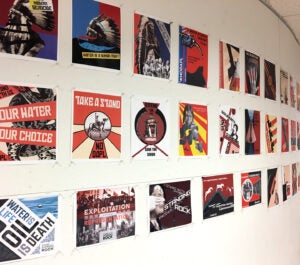
Dakota Access Pipeline protests, also called by the hashtag #NoDAPL .
Students had studies the bauhaus design and did research on the DAPL and created poster designs.

After learning the tools in illustrator and talking about branding and typography students design a logo, do variations and design business cards for the business and learn about the printing process. Work by Michelle Motta.
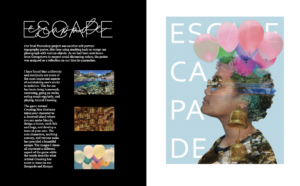
Students learn to do a portfolio newsletter in InDesign for their projects. This a spread from Nia Jordan’s portfolio.
Arts 162-01 — Introduction to Graphic Design: Students will learn the formal, aesthetic, and communicative aspects of creating effective graphic images. Projects include logos, typography, and digital arts that promote mastery of techniques, methods, and materials. In order to foster creativity, we start with breathing meditation at the start of class, followed by discussions about design and learn the Adobe software and the foundation of design principles. The goal of this class is to strengthen students’ visual literacy and communication skills as part of their liberal arts education.
This course is taught by Professor Negar Nahidian.
ARTS 162 02 – Intro to Graphic Design
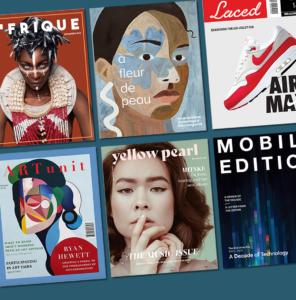
Student multilingual print and interactive magazines based on chosen topic, major or minor
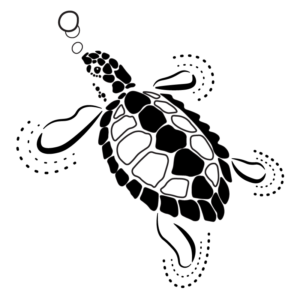
Chiara Lewis, translation drawings, pre-logo

Angela Perez, logo design and branding, laser etched and cut Maker Hub promo item
ARTS 162 02 — Intro to Graphic Design is a studio art class focused on the creation of graphic design assets for print and screen-based media. During this course, you will learn basic Adobe Illustrator, Adobe Photoshop, and Adobe InDesign software through real-world projects and current topics in graphic design. The course seeks to familiarize design students with the communicative power of visual form and to help students develop a personal process of creating original graphic forms capable of effectively communicating a message or information. Projects integrate the following topics: principles of graphic design, design research, logos and branding, album cover design, interactive and print publication design, typography, graphic design history, and professional portfolios.
This course is taught by Professor Toni-Lee Sangastiano
ARTS 262 — Graphic Design II
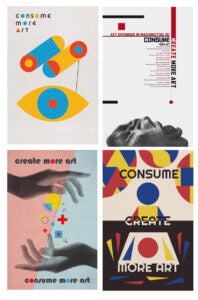
Bauhaus Poster: Consume More Art, Create More Art
After studying the Bauhaus, students were asked to do a poster project based on the Bauhaus principals Design, typography and use of color. Top left: Shana Bottom left: Kate Gregory Bottom right: AndresSiles-Loayza Top right: Edson Martinez
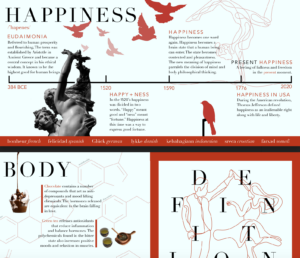
Happiness book:
Students were asked to do the layout and design of a book and send it to print.
They were asked to use Adobe illustrator and photoshop for the images and Adobe Indesign for the layout and typography. Work by Juliette Silvain.
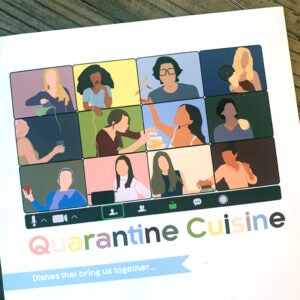
Quarantine Cusine book:
Each student was asked to share their one favorite recipe and to design and do the typography and layout of a spreading he book. Work by Anne-Isabelle de Bokay.
ARTS 262 — Graphic Design II Students will learn the mindful, formal, aesthetic and communicative aspects of creating effective graphic images. Typography, the history of type, type classifications and more will be taught and discussed. Students will design a book in Indesign and send to print, along with a type classification project cards, and other projects.
This course is taught by Professor Negar Nahidian.
Animation
ARTS 166-01 — Animation I
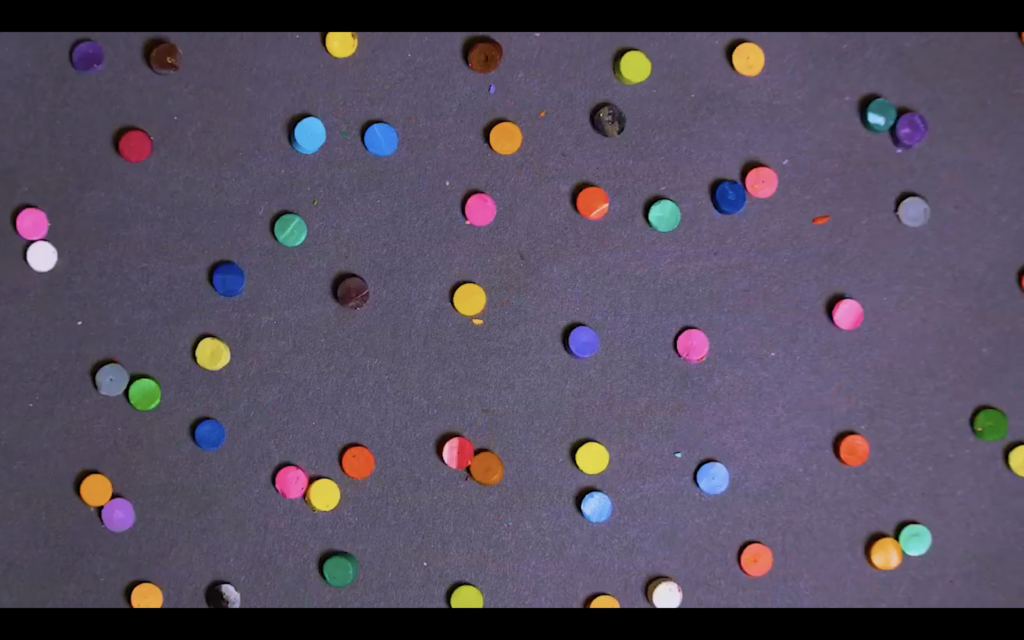
Screengrab from film by student Sarema Shorr
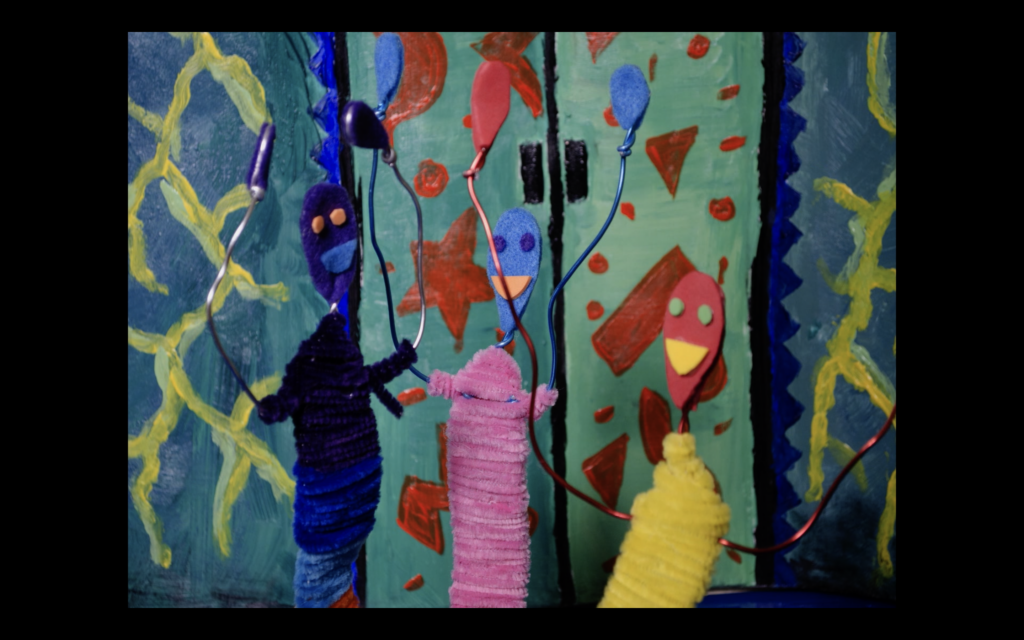
Screengrab from film by student Renata Garcia

Screengrab from film by student Shana Shin
ARTS 166-01 — Animation I is designed to introduce students to basic methods and practices in animation, while exposing them to artists working independently in the field. The course will provide an overview of techniques ranging from hand-drawn frame-by-frame animation, to object animation and pixilation. Each class will consist of a short demonstration, viewing of related works, hands-on experimentation and critique. Weekly assignments will further students’ exploration of animation approaches and techniques. The course will conclude with the creation of final projects in which students will develop and create an animated short in a medium of their choosing.
This course is taught by Professor Elyse Kelly.
ARTS 266 — Intermediate Animation
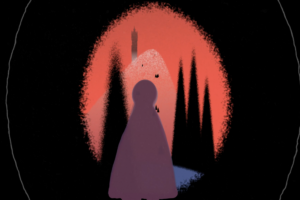
Screengrab from film by student Sarema Shorr

Screengrab from film by student Margaret Neely
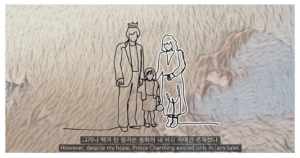
Screengrab from film by student Shana Shin
ARTS 266 — Intermediate Animation This class is an intermediate course that explores experimental and traditional animation practices through exercises using 2D digital techniques. Each week will consist of a lecture, screening of related works, and a lab. By the end of this course students will be able to execute short animations, visually express both abstract concepts and conventional narratives, and identify how animation principles affect all animated work be it digital or analog, independent or commercial, refined or rough. Students are expected to play, take risks and work outside their comfort zones.
This course is taught by Professor Elyse Kelly.
Upper-Level ARTS Courses
ARTS courses at the 300-400 level are designed primarily for Art Majors, Minors and advanced students who want to work with a professor on one or several independent projects over the course of the semester. These courses require approval. Please inquire with the individual instructor for more information.
These courses include:
ARTS 221 — Directed Study in Printmaking
ARTS 312 — Drawing III: Directed Studies
ARTS 321 — Printmaking: Directed Study
ARTS 330 — Photography Studio III
ARTS 351 — Painting III: Directed Study
ARTS 355 — Advanced Painting Studio
ARTS 358 — Advanced Painting Studio II
ARTS 431 — Photography IV-Directed Study
ARTS 435 — Adv. Photography Studio
ARTS 455 — Adv. Painting Studio
ARTS 470 — Art Internship
Art History Courses
Ancient to Medieval Art
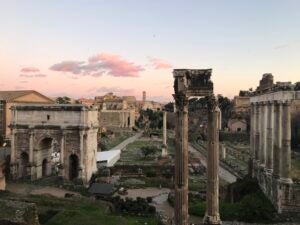
View of the Roman Forum – taken in December 2019 by Prof. Tilney
ARTH 101 — Ancient to Medieval Art surveys the art and architecture from the Paleolithic period through the Gothic period. Within a roughly chronological structure, we will explore the art of these periods in relation to their broader cultural, intellectual and historical contexts. In addition to emphasizing the developments that define each historical period, we will consider the aesthetic advances made with the painting materials and methods available at the time.
This course is taught by Professor Barrett Tilney.
Renaissance to Modern Art

ARTH 102 — Renaissance to Modern Art This course surveys major work and developments in European and American painting, sculpture, and (to a lesser extent) architecture from c. 1300 to the present. We focus on changing aims, means, and perceptions of art amid political, religious, social, economic, and other contexts. What have artists, patrons, institutions, and others wanted works of art to accomplish, and in what ways?
This course is taught by Professor Alfred Acres.
What is Good Taste?

Maurizio Cattelan, America (2017)
ARTH 150 — What is Good Taste? This course is an introduction to art historical ways of knowing, and to the humanities more broadly. It takes as its premise longstanding ideas of “art appreciation,” connoisseurship, and aesthetic judgment, but asks students to consider where our ideas of taste come from. What counts as art? What counts as good art? Where does the “canon” come from and what are its limitations? Who is art made for and where is it meant to be encountered? Along the way, this course will consider art from around the world and, yes, refine your critical faculties. Ultimately students will develop tools to help think not only about art, but how and why they are doing so.
This course is taught by Professor Ian Bourland.
Baroque Art & Architecture
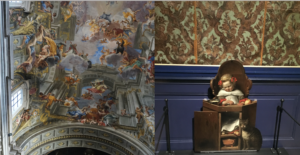
Left image: Church of Sant’ Ignazio, Rome, Rome, Ceiling fresco detail of Glorification of St. Ignatius, c. 1685 by Fra Andrea Pozzo. Photo December 2019. Right image: Johannes Verspronck, Boy Sleeping in a Highchair, 1654, (taken in Art and Laughter Exhibition, Frans Hals Museum, Haarlem).
ARTH 230 — Baroque Art & Architecture introduces students to painting, prints, sculpture and architecture produced in the seventeenth century – the age of the Baroque. In this century of remarkably varied artistic production, regional distinctions arise in the context of explosive scientific discoveries, significant political changes, transformed religious beliefs, and wide reaching trade and exploration. We will examine selected works of art produced by artists such as Caravaggio, Velazquez, Poussin, Rubens, Rembrandt and Vermeer in Italy, Spain, France, Flanders and the Dutch Republic in the framework of the cultural, political, religious, and intellectual changes that make the art of this period so distinctive.
This course is taught by Professor Barrett Tilney.
ARTH 250 — Modern Architecture: US and EU
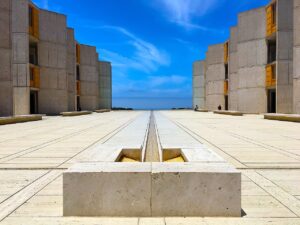
Louis Kahn. Salk Institute for Biological Studies. La Jolla, CA 1965
ARTH 250 — Modern Architecture: US and EU This course surveys modern architecture from 1750-Present. Our analysis will focus primarily on movements and designers in the United States and Europe with additional global examples. Characteristics of key architectural styles and the designs of leading architects will be discussed within the framework of their cultural context. We will address the skyscraper’s development, the Arts & Crafts movement, the International Style, and later modern forms. Visionary urban plans, new technology and architectural ornament will be highlighted. Among the many architects we will address are Jefferson, Labrouste, Wright, Morgan, Hadid and Ando. Themes highlighted in our study include issues relating to gender, race, and sustainable/green design. Students will work both independently and in teams throughout the semester. No prior architecture knowledge is required or assumed.
This course is taught by Stephanie Rufino.
American Art

Left to right: Iroquois, Washington Covenant Belt and Hiawatha Belt: 1775 and 1789, shell beads, Onondaga Nation; John Singleton Copley, Watson and the Shark, 1778, oil on canvas, National Gallery of Art, Ferdinand Lammot Belin Fund, 1963.6.1; David Drake, Twenty-Five Gallon Four-Handled Stoneware Jar, 1858, stoneware with alkaline glaze, Crystal Bridges Museum of American Art, Bentonville, Arkansas, 2021.29; William Matthew Prior, Three Sisters of the Copeland Family, 1854, oil on canvas, MFA Boston, Bequest of Martha C. Karolik for the M. and M. Karolik Collection of American Paintings, 1815-1865, 48.467, Augustus Saint-Gaudens (1848–1907), Shaw Memorial, 1900, patinated plaster, U.S. Department of the Interior, National Park Service, Saint-Gaudens National Historic Site, Cornish, New Hampshire, on long-term loan to the National Gallery of Art, Washington, Thomas Eakins, The Champion Single Sculls, 1871, oil on canvas, The Met, Purchase, The Alfred N. Punnett Endowment Fund and George D. Pratt Gift, 1934, 34.92.
ARTH 251 — American Art The United States has always been a nation of diverse people, and the growth and development of its arts have been shaped by the exchanges it fostered. This course will explore how the artistic traditions of northern and southern Europe, Native America, Asia and Africa converged in the United States and how circumstances of the country’s environment, culture, politics, and materials shaped artistic production from the colonial era through 1876. We will examine work by artists such as John Singleton Copley, Sarah Miriam Peale, Thomas Cole, David Drake, Robert Scott Duncanson, Albert Bierstadt, Winslow Homer, and Thomas Eakins—as well as distinctly American art forms such as pipe tomahawks, ledger book paintings, chinoiserie, New Mexican santos, and middle class vernacular art. Students will be expected to develop an understanding of the major artists, art movements, and art historical issues related to the visual arts produced in the United States. The course will include one Friday site visit to the National Gallery of Art.
This course is taught by Professor Lisa Strong.
Byzantine Empire
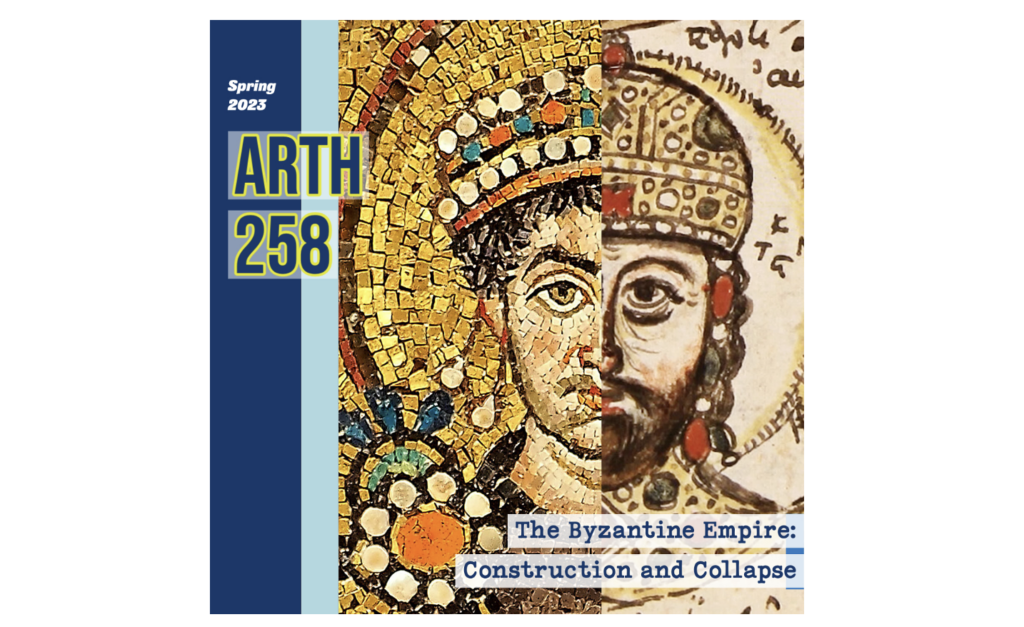
(Left) Detail of Emperor Justinian, Imperial panel apse mosaic (547 CE), Basilica of San Vitale, Ravenna.
(Right) Detail of Constantine XI Palaiologos, Imperial portrait (15th century), History of John Zonaras, Mutinensis gr.122, f.294r, Biblioteca Estense Universitaria, Modena.
ARTH 258 — The Byzantine Empire: Creation and Collapse Lasting for over 1100 years, the Byzantine Empire – or properly known as the Eastern Roman Empire, stood as one of the longest enduring kingdoms in history. This course explores the evolution of this empire from Constantine’s creation of a “new Rome” with his relocation to Byzantium in 330 CE, to its final years under Constantine IX Palaiologos as it fell to the Ottoman Sultan, Mehmed II in 1453. As the Byzantine empire expanded, contracted, suffered civil wars, reconciled the Sack of Rome, and confronted the rise of both Abbasid and Umayyad caliphates, artists both at the court and beyond engaged in a rich dialogue of material culture (jewelry, ivories, enamels, textiles, manuscripts, sculptures, paintings, and architecture). Throughout this course, we will examine how the production and circulation of visual culture illustrates a variety of functions for each phase of the empire, be that promoting global influence, cultivating a recognizable and replicable style, or manufacturing propaganda to combat political defeats. Students will consider issues of trade and commerce, race and cultural migrations, gender and the role of the empress, theological debates during the era of iconoclasm, and the impact of crusades.
This course is taught by Professor Tiffany Hunt.
Modernism & the Islamic World

Baya (Mahiedinne), Woman with Two Peacocks and Aquarium, watercolor and gouache on paper, 1968. Barjeel Art Foundation.
ARTH 356 — Modernism & the Islamic World This course focuses on artistic modernisms that emerged from the Islamic world starting around 1860, when globalizing markets, new technologies, and profound political upheaval stimulated widespread artistic transformations. Studying both artworks and the written works of artists and critics who lived and worked in North Africa, West Asia, and Southeast Asia from 1860-1990, this course will examine how artistic modernisms—from surrealism to ecocritical art—were explored and shaped by artists in the Islamic world. From proponents of the hurufiyya movement in Iraq who experimented with the expressive and globally translatable qualities of abstracted Arabic letter-forms, to Moroccan artists of the Casablanca School who found decolonizing tools in creating immersive experiences, artists from the Islamic world formulated artistic techniques and styles deeply responsive to their changing contexts. No prior knowledge of the history of Islamic cultures is required and students with interests in related subjects are encouraged to attend.
This course is taught by Professor Nisa Ari.
Queer Art & Visual Culture

Felix Gonzalez Torres, “Untitled,” 1991; Clifford Prince King, “Just the Two of Us,” 2019; Nao Bustamante, “America The Beautiful,” 2002.
ARTH 359 — Queer Art & Visual Culture This course surveys the production of queer art and visual culture from the mid-20th century until the present. The course utilizes queer, queer-of-color critique, feminist, and Black feminist theories, as well as performance, cultural, and affect studies to ground the emergence and growth of an expressly queer, trans, non-binary, and non-conformist identity and aesthetic in art. The course considers traditional and non-traditional modes of art production, including painting, photography, video, sculpture, new media art, installation art, performance art, public art, etc. Students will closely study, analyze, theorize, and contextualize works of art and trends by LGBTQ artists within an American and a transnational context.
This course is taught by Professor Andy Johnson.
Spectacle in Latin America

ARTH 417 — Spectacle in Latin America: The seminar seeks to develop new approaches to the visual and ephemeral material cultures of rituals, festivities, ceremonies, and processions that helped articulate pre-and post-conquest societies in Latin America. The course studies the evidence in codices, paintings, prints, music, dance, costume, ephemeral art, and ancient and modern rituals. Mesoamerican, Andean, and Viceregal’s understanding of existence exhibited a profound sense of the theatrical, which was inextricably linked to religious, political, and cultural spheres. By examining the evolution of spectacle in Latin America from ancient times to the present, the seminar considers definitions, source materials, and interpretative issues in the study of ritual and ceremony. The course explores how rituals create and maintain—or transform—a society’s cultural identity and social relations while investigating the inherent problems of ephemeral and often unscripted and unrecorded practices. Placing particular emphasis on social, historical, sensorial, cultural, economic, and political aspects, the course introduces students to major theoretical concepts of belonging, inclusion, and exclusion. Moreover, the seminar aims to understand identity construction while challenging the intersection of art, spectacle, memory, tradition, race, and class in Latin America.
This course is taught by Professor Andrea Gallelli Huezo.
Dürer

ARTH 426 — Dürer: The seminar explores the immensely original art of Albrecht Dürer (1471-1528) and the incredible range of interpretation it has attracted. Our main focus will be on the works themselves and will include time spent together with prints, drawings, and paintings in the National Gallery of Art. One Dürer’s appeals for modern observers is the breadth of his engagement with many spheres, including religion, politics, local and foreign cultures, gender relations, study of nature, witchcraft, humanism, international travel, art markets, technical innovation, publishing, and radical reformulation of the very idea of the artist as a unique individual in society. We can also ask: what does it mean to study an “old master” in 2023? Questions about mastery are especially vivid with Dürer, who was more self-conscious about the concept than any other pre-modern artist. Can art from this period shed light on any of the urgent questions and concerns of our own time? Should it have to? Both questions can be answered with a tentative yes. But the more interesting question is how.
While one or more previous courses in art history provide useful grounding for this course, no specialized knowledge of Dürer or his period is required or assumed.
This course is taught by Professor Alfred Acres.
BACK TO TOP
Art in the Digital Age
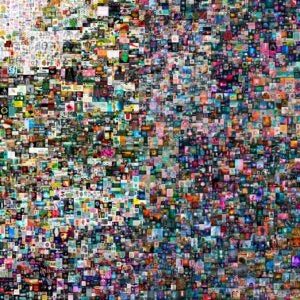
Beeple, Square
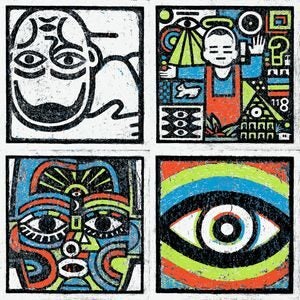
Jake Fried, Baby Eyes

Beeple, Everyday’s Pilgrimage
ARTH 449 — Art in the Digital Age: Last year, the artist known as “Beeple” sold a digital collage online at Christie’s auction house for almost $70 million dollars. With the image came an NFT, or non-fungible token, a digital certificate of authenticity to protect the buyer. Now Beeple is planning a museum of digital art in Charleston, SC, part of a trend of digital transformation in the “Metaverse” (loosely, “an embodied virtual-reality experience”). From its more industrial origins – gaming, fashion – the phenomenon of the Metaverse has now entered the cultural realm, with implications for museums, works of art, and the sales and marketing of virtual art objects via cryptocurrency in the Blockchain. The situation raises critical questions about the very nature of art in the Digital Age, how it is made, what it looks like, how it is bought, paid for, and viewed by collectors and investors. Is this trend just a fad and already a bust? Does digitizing art and selling rights to it democratize access to art, as has been claimed, or are baser intentions in play? With the participation of a digital artist, a business director for NFT projects at an auction house, a curator, and more, the class will explore these issues in depth.
This course is taught by Prof. Elizabeth Prelinger.
Senior Thesis
ARTH 490, Senior Thesis: By arrangement with a faculty adviser, majors may write a senior thesis on an art historical topic of their choosing. The thesis is optional, but can serve as a capstone course that prepares students for future professional or graduate work.
BACK TO TOP
Art & Museum Studies Courses
AMUS 509 — Museums & Community Engagement
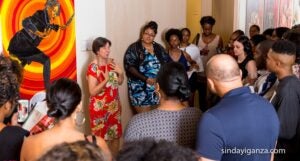
Community Tour of ‘Forward Ever. Backwards Never exhibit’ at Weeksville Heritage Center.
Photo Credit: Dominique Sindayiganza Photography.
AMUS 509 — Museums & Community Engagement focuses on the lifecycle of outreach, participation, and impact, communicated between museums and audiences through a lens of equity. The course is a practical exploration of museums’ complex conjunctions with the space they steward and the publics they serve through the lens of the community. In our increasingly polarized world where societal upheaval and public institutional critique have become the norm, many museums are pivoting to more holistically serve and help visitors interpret and interrogate the world through a lens of social justice. Museums & Community Engagement will feature case studies, readings, and guest lectures that speak to ways institutions enrich, educate, and partner on programs with diverse audiences. Students will learn, deconstruct, and redefine “community” and who and what that encompasses to further illustrate efforts around programs and partnerships from every angle.
This course is taught by Professor Monica Montgomery.
Spring Internship
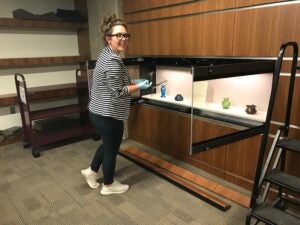
Frances Williams curating the Art Collection, Booth Family Special Collections
AMUS 531 Spring Internship — Internship in museums or arts organizations.
BACK TO TOP
Museum Administration
AMUS 550 — Museum Administration provides an overview of leadership, management, and administrative department functions within a museum setting. The topics we will explore include nonprofit organizational structure and governance, board/staff relations, strategic planning, human resources oversight, development, marketing and PR, emergency preparedness, and how to serve diverse audiences. Students will benefit from museum site visits, guest speakers, in-class activities (lectures, recent news from the field discussions, small group exercises), assignments and readings. We will learn how to interpret financial statements, which are of special interest to funders such as government granting agencies, and museum annual reports. Writing sample grant proposals, marketing plans, project budgets, and strategic plan summaries are some potential exercises that will provide students insight into several museum administrative career tracks. Students will also learn about current and new management tools to support museums responding to social change through understanding organizational and community contexts, informed decision-making about collections, interpretation and programming, and garnering new public and private support for these important initiatives.
This course is taught by Professor Al Miner.